Introduction
Nearly two decades ago, photo historian Douglas Nickel observed that traditional art history had not yet developed the tools for handling non-art photographs.1 In many ways, much progress has been made since 2001: vernacular photographs of every kind have become worthy objects of study for scholars and critics—not only within visual culture, but in history, sociology, anthropology, and literary and cultural studies. In fact, these days, as Nickel himself has pointed out, studies of vernacular photographs outpace the production of monographic books about “fine art photographers.”2
However, it remains difficult for art historians to build an interpretative model that takes full measure of the visual subtleties of non-art photographs—including their unexpected aspirations towards the aesthetic—without slighting the historical and social conditions in which they were produced.3 With that challenge in mind, I consider here those very aspirations, as they surface repeatedly in a group of “medical portraits”: casebook photographs of patients made between 1885 and 1916 at the Holloway Sanatorium in St. Ann’s Heath, Virginia Water, Surrey, England (fig. 1). My intention is to offer the beginnings of a method that might help us both identify, and extract meaning from, the aspects of the images that cannot be accounted for by the conventions of medical or scientific representation. In so doing, I recognize that as objects of study these photographs cannot be detached from the entangled motivations that shaped their production, or the material conditions to which they remain bound.
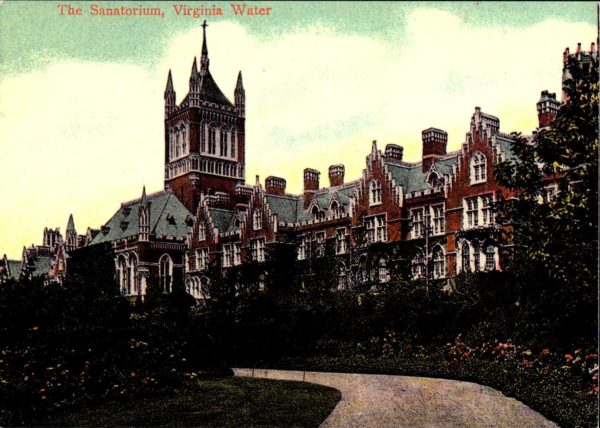
To cite just an obvious departure from institutional convention, the dry-plate paper photographs produced of about a third of the patients at Holloway were scissored into various shapes—some more ornamental than others—and glued, pinned, and tucked into carefully incised corners, or loosely inserted into the pages of large, leather-bound casebooks. These folios contained the staff’s narratives of their patients’ case histories, which were inscribed upon admission in the following order: name, religion, occupation, marital status, number of children (if any) medical and family history, and the date and duration of the “precipitating incident” that had prompted the patients’ relatives or doctors to bring them to Holloway in the first place.
Holloway was not an ordinary nineteenth-century insane asylum; it was a “benevolent asylum for the mentally afflicted of the middle classes.”4 Thomas Holloway, the original founder, a highly successful merchant of medicinals looking for a salutary way to distribute his inheritance, was inspired to build such a sanctuary by a speech delivered by Lord Shaftesbury, the liberal MP and philanthropist who pointed out that the middle and upper-middle classes were under-served populations: too well off for the pauper asylum, yet not wealthy enough to be tended at home by servants and a shamed if compliant family.5 The lavishly decorated, beautifully landscaped Gothic revival structure by William Crossland was erected on twenty-two acres of rolling hills on St. Ann’s Heath, Virginia Water, Surrey, and easily reached by rail from London (fig. 2a).6 Holloway opened to much fanfare in 1885, at a ceremony attended by the Duke and Duchess of Wales. The sanatorium was originally imagined “for the unfortunate student who has overdone cramming for some public examination, for the over-worked barrister or clergyman, for those whose minds are filled with illusions on account of domestic troubles or bereavements.”7 About a quarter of the patients admitted were “Voluntary Boarders,” who desired an escape from the strains of life, and could afford to admit themselves without being “certified.” They were allowed not only to roam the grounds, but also to visit the neighboring village, without supervision. Eventually about half of the VBs, as they were called, were certified and admitted to Holloway, with mixed results. Others began as certified patients and decided to stay on as Voluntary Boarders after they had officially been pronounced “recovered.”8
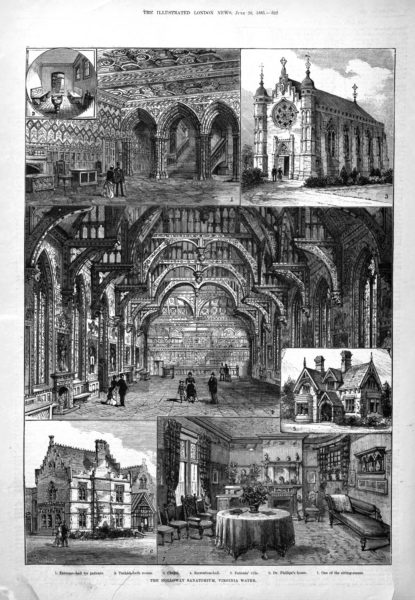
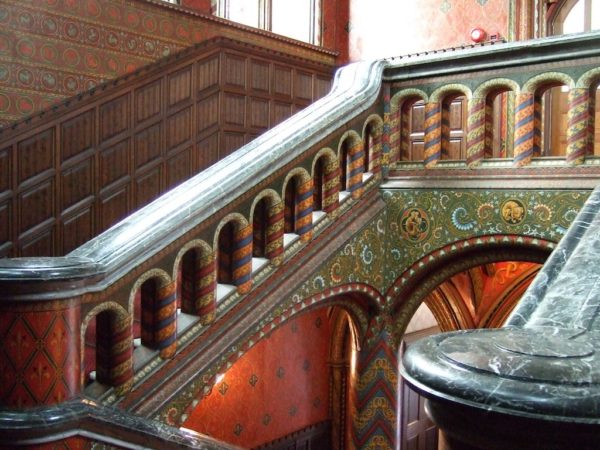
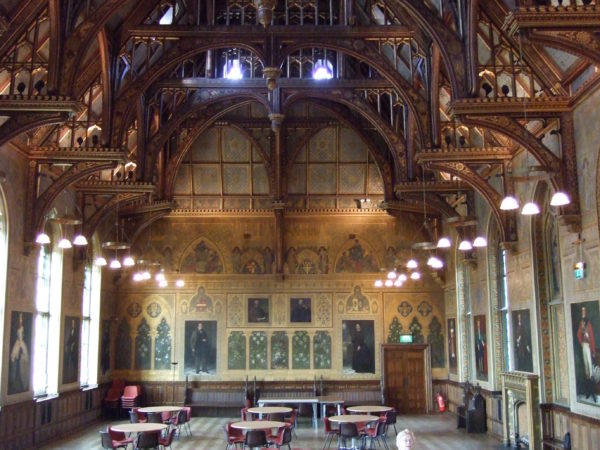
The interiors of the “benevolent asylum” were painstakingly decorated and beautifully furnished; Crossland’s Gothic revival style featured lofty, arched ceilings and hand-stenciled foyers (fig 2b, fig 2c). There were individual villas for visiting families who wished to bring their servants. In the words of George Martin-Holloway, the brother-in-law of Thomas (who died before the plan could be fully realized), “a cultivated person whose mind is affected will never be cured if surrounded by vulgar accessories.” The monumental stone entryway, for example, was brightly gilded, because otherwise the cold grey “would sit heavily on a mind diseased.”9
The emphasis at Holloway was on integrating the patients back into the lives they had left behind. Thus, myriad conventional upper middle-class activities were offered. There were cricket games, dances, theatricals, and strolls around the grounds, even the possibility of riding one’s own horse, which could be stabled on the grounds. Since the majority of the patients were from well-off, educated families, the most advanced treatments and the newest drugs were expected to be utilized (electrotherapy, exercise, digitalis, bromide, hypodermic morphia and purgatives were among the most favored).10 The sleeping quarters of patients were segregated by gender—although spaces such as the dining room and parlors were available to both male and female patients who demonstrated appropriate social behavior. The casebooks were organized by gender, and separate folios were kept for Voluntary Boarders, although the narratives in these are far more rudimentary, and the photographs few.
The Shadow Archive
Over thirty years ago, Allan Sekula famously characterized the vast compendium of nineteenth-century photographs of “the poor, the diseased, the insane, the criminal, the nonwhite, the female” as “the shadow archive.” According to Sekula, this archive stood as the antithesis to the imagery of the wealthy and celebrated, an opposition that he distilled as “the honorific and repressive poles of portrait practice.”11 Sekula was largely correct. Most photographs that comprise the taxonomies of the guilty, the insane, and the deviant of these years did generally conform to roughly the same format: a rectangular, occasionally square, image of a frontal or profile view of a bust-length figure, whose face betrayed little or no affect. In fact, this very type of image was employed around 1900 at an institution just a few miles away from Holloway: the Ewell Epileptic Colony (later St. Ebba’s Hospital) in Surrey (fig. 3). At Ewell, a mug-shot like view of each patient was taken at the time of admission, and pasted at the top of the casebook page, with the pertinent medical history written directly below. Both the timing of the image and its use as an exemplary illustration of symptoms described in the narrative were straightforward, as was the organization of the narrative itself.
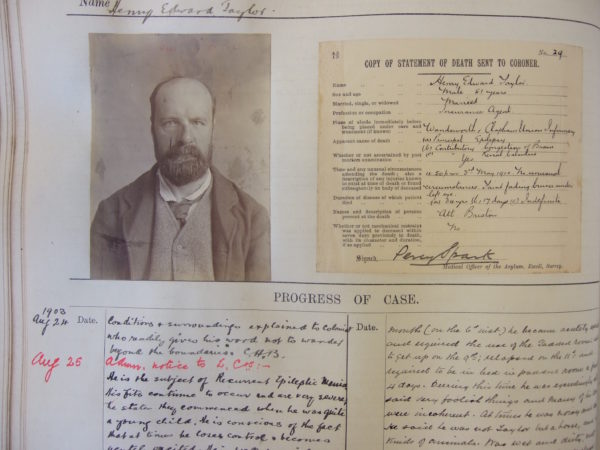
At Holloway, only some of the patients were pictured—no record of an organizing principle for determining how they would be identified has emerged. We do know that the pictures we have represent only the patients who agreed to be photographed. The timing of this process was unpredictable, and could range from days or even months after admission to shortly before discharge. In fact, photographs could be taken anytime within the patient’s stay, which lasted anywhere from a few days to decades—a duration that went against the express wishes of Thomas Holloway, who had intended that no patient should remain for more than six months.12
Aside from the fact that Holloway’s casebook photographs were cut into a variety of shapes, the patients themselves were featured in a range of poses, facial expressions, and manners of address to the camera. We see everything from a blank stare or a knowing sidelong glance, to an intensely searching gaze that appears to be reaching through the camera lens, as if to collapse the physical distance between the subject and the photographer. The pictures were produced by collective authorship, by largely anonymous staff members who sporadically initialed the images they made. On a number of occasions, multiple patients would be photographed on the same date, and in roughly the same format, suggesting that some of the work was done by itinerant photographers who would have been paid by the day.13
The very first Holloway casebook (1885–1897), dedicated to female patients, which I have written about elsewhere, includes some rather stunning anomalies in the history of medical photography.14 Not only are there a number of group portraits in this folio (fig. 4a and fig. 4b), the casebook also includes single-figure images of fashionable women patients that betray not a single trace of their institutional location (fig. 5) nor any sign of the presumed mental strain or deviant behavior that precipitated their admission to Holloway.
The group portraits in the first casebook were by and large composed of women whose histories were replete with accounts of their anti-social behavior. The case histories attest that at least some of the subjects were averse even to rising from bed in the morning, let alone getting properly dressed up to be photographed. None of the women pictured in either fig. 4a or fig. 4b were known to be particularly communicative—with either the staff or the other patients. Yet here they are together, not unlike relatives at a family reunion who do not know each other well, although they share a certain lineage. There are signs of deviance (anomalies of gaze or pose), but they are not obvious. The variations in class position—for Holloway did accept some patients from workhouses and public hospitals—are more overt and conveyed by the subjects’ costumes, which range from feather-trimmed coats and fur muffs to plain work jackets and skirts made of visibly coarse fabric. In the single-figure photographs the subjects use the exterior colonnade of Holloway as a veritable stage for their skills as elegant hostesses, which have presumably remained undiminished during their stay. Maria W. (fig. 5), in fact, has styled herself as a fashion plate, a perception reinforced not only by her idiosyncratic costume, but by a silhouetted pose that could have been lifted from a copy of La Mode illustrée.
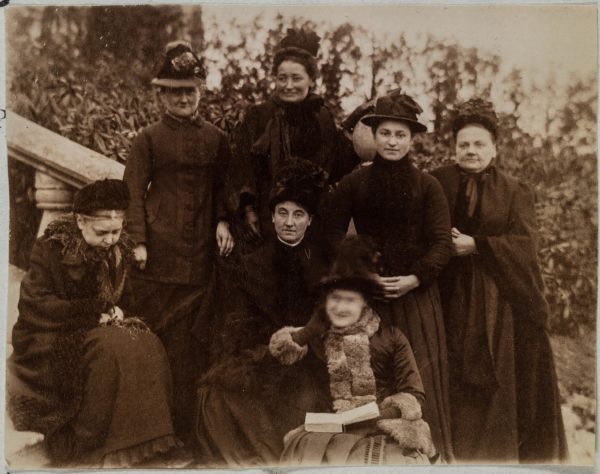
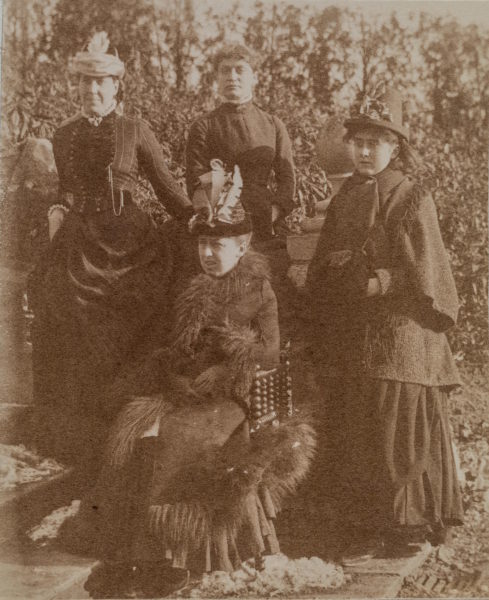
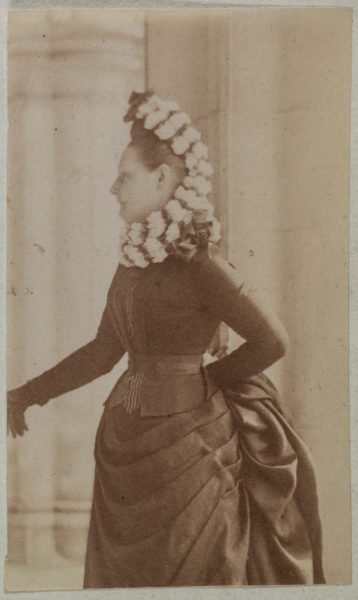
Objectivity: Variations on a Theme
As Peter Galison and Lorraine Daston have pointed out, “policing objectivity” during the nineteenth century demanded that the scientific photographer renounce both theorizing and aestheticizing.15 The Holloway images appear to violate both prohibitions, in ways that are difficult to class. They neither fully embrace the aesthetic nor do they unconditionally repudiate the objective, veering between a kind of idiosyncratic, suggestive portraiture and a systematically unsystematic documentation. In their structure, function, and manner of presentation these photographs enact the very tensions that emerge when the boundaries between the objective and aesthetic are assumed rhetorically, but visually stretched to breaking.
At first glance, insisting on the relevance of aesthetics to the Holloway casebook photographs may seem profoundly misguided. As material objects, the pictures are, literally, rough around the edges: crudities of lighting, exposure, framing, and presentation abound. For the most part, the settings for the patients’ portraits seem to have been improvised. Despite the photogenic, decorative surfaces that were abundant at Holloway—hand-stenciled walls, carved architectural details, and ornamental fireplaces—the backgrounds that frame the subjects are at times distractingly shabby. Perhaps the relative lack of visual finesse was deliberate, a self-conscious affirmation of the medical photograph’s status as a scientific, non-art object—an expression of what Martin Kemp has identified as a “rhetoric of objectivity.”16
Yet the sheer variety of forms and presentational strategies that recur in these casebooks serve no obvious function within such a rhetoric. Some pictures are marginal strips cut to fit into the narrowest possible space, clearly subordinate to the “primary” text of the case-notes. Others are larger, square and flat, emulating the proportions of an identity card, and are pasted firmly into the center of the casebook page, “framed” by the text. Still others mime the conventions of a studio family portrait, or a sentimental album picture, having been shaped into an oval. A number of patients’ images are faceted like old tintypes; and occasionally a picture has the ghostliness of a one-of-a-kind daguerreotype. Although the photographs were, in principle, reproducible, as any dry plate photo would be, their context is singular, and impossible to recreate. The sheer variety of the pictures’ material properties and their surrounds, absent any prevailing logic to account for them, lends each of these photographs the potency of an original—precisely the opposite of the monotony we have come to expect of institutional photography.
And while the collective authors of these pictures may not have employed the more obvious trappings of the late nineteenth-century portrait studio—fur rugs, free standing columns, painted backdrops—they did consistently employ schematic, improvised variants of its signature conventions. In most cases there was at least a modest background, a self-conscious pose, deliberate framing, and a visible address—or resistance—to the camera. It is critical to remember that the families who chose to have their son, wife, daughter, or husband admitted to Holloway would have been among photography’s most eager consumers, even if the family member who was the patient was not included in the images typically circulated to document the family’s life. The Holloway pictures exist at an oblique angle to the usual portrait conventions, neither fully refuting nor embracing them, but offering us new composites that challenge the boundaries between what are usually regarded as distinct formats, as well as functions.17 The multiplicity of unfamiliar forms and approaches promotes a confusion as to the purpose of the photographs. It is often unclear as to whether the photographs produced at Holloway were intended to record, produce, or suppress the conditions that were their ostensible raison d’être.
The casebook photographs seem simultaneously archaic and experimental. There is a restlessness about them, as if the entire inventory of the history of photography to date is being appropriated, only to be partially cast off, or reinvented. Not only are there visual affinities with historical formats, such as the daguerreotype or tintype; there are intimations of the future in sequential, almost cinematic images. It is a rehearsal of photography’s own history, a vigorous, even if apparently naïve, plundering of its myriad tools and effects.18
Nine of the Holloway folios at the core of this essay are now housed at the Wellcome Library in London; forty-two are in the collection of the Surrey History Centre in Woking.19 Some of the casebooks are in relatively good condition, others have suffered from water or fire damage, a number of them are simply lost. It should be emphasized, however, that their survival is due principally to a group of heroic archivists who quite literally rescued them from either the “skip” or a series of bonfires set by squatters who had settled in the half-abandoned asylums of Surrey in the 1980s and 1990s, when many of these institutions were de-commissioned.20 (Occasionally, a missing volume surfaces. The Wellcome Trust purchased one on eBay several years ago).
Between the Aesthetic and the Objective
I concentrate here on a selection of the casebook photographs that pose a significant challenge to the standard assumptions about non-art photographs, especially when they are produced within a medical or scientific context. Special attention is given to those pictures that seem to hover somewhere in the space between the aesthetic and the objective—or perhaps, more precisely, in a register where the distinctions between these categories become so attenuated as to be virtually unrecognizable. I see this in-between space not simply as a site for formal experimentation, but as an opening for an interaction between the patient and the photographer, through which that patient could push against the enforced passivity of the institution—however subtle the signs of Holloway’s purpose remained.
My hope is to write about the Holloway photographs with the kind of nuanced historical eye that I continue to believe art historians possess in a way that is distinct from that of most practitioners in related humanities and social science fields. The process is admittedly difficult, and the development of a method worthy of these images is ongoing. Although I have embraced the idea of “interdisciplinarity” in my own work, and actively participate in many such initiatives across my university, I am intent here on underscoring what art historians know how to do better than anyone else: comprehend and enunciate how images and art objects are repositories of knowledge—especially when that knowledge is embedded in unexpected forms and spaces.21
The Medical Portrait
Medical portraits are themselves equivocal, hybrid objects. A growing literature has emerged to grapple with the ambiguities of the genre, challenging the conventional assumption that a medical image or object is equivalent to an empirical study, a confirmation of a text that has already been written, a diagnosis already delivered.22 In its broadest terms, the medical portrait can encompass oil paintings, sculptures and prints of both physicians and patients; tinted wax moulages of faces and body parts, originally made as teaching tools to demonstrate the visual signs of disease or defect; and painted plaster casts of body parts.23 But, as Ludmilla Jordanova has recently emphasized, photography is the medium that has been the focus of most of the discussions, and generated the greatest controversy.24
Unsurprisingly, the photographic medical portrait is considered to be especially fraught when the subjects represented have been judged to be mentally ill. Two groups of images have dominated the discussion over the past twenty five years: the pictures taken directly by Hugh Diamond, doctor and Superintendent of the women patients of the Surrey County Asylum (and founding member of the Photographic Society of London) during the 1850s (fig. 6); and those staged by the photographers working under Albert Londe for neurologist Jean-Martin Charcot in Paris at the Salpêtrière Hospital (fig. 7).25 Both Diamond and Charcot readily displayed the photographs they either took themselves or presided over: Diamond exhibited them within his own asylum, and even showed them to patients, hoping that visual evidence of their troubled states would spur them on to better health.26 Londe and his fellow photographers knew from the outset that their images were intended for publication in Charcot’s medical journal, the Nouvelle iconographie de la Salpêtrière, which was published from 1875 to 1893, as a kind of visual atlas of the bodily evidence of neurological disease and defect.
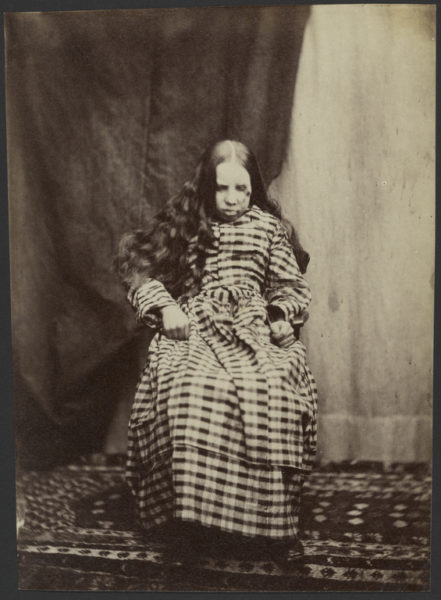
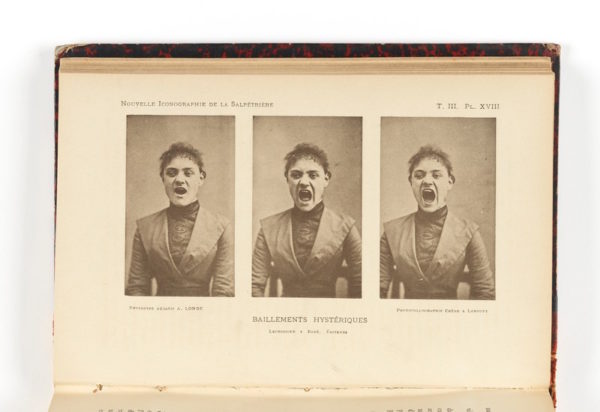
Diamond’s and Charcot’s photographs were produced roughly thirty years apart. And naturally there are obvious differences in format, scale and effect: most of Diamond’s were half-length and focused on the uncomprehending expression of the patient. The majority of Charcot’s staff’s photographs represented the full figure, the better to display the full array of deviations in bodily comportment that revealed neurological defects, including the nine states of hysteria. Despite these obvious differences of form and emphasis, and a generation’s worth of change in the treatment of the mentally ill, the photographs produced by Diamond and Charcot and their surrogates shared two fundamental assumptions: an unequivocal faith in the transparency of the photograph, and a conviction that the patients they studied and photographed were unmistakably other. Almost all of the women whom Diamond photographed at the Surrey County Asylum appear definitively out of reach of conventional social exchange: compliant enough to be photographed, but unresponsive to any demands made by the photographer as to affect or expression. They have none of the decorum of the engaged, complicit subject. The photographs of Charcot’s patients fully intended to “make hysteria perceptible on the body’s exterior,” as Mary Hunter has put it. The more theatrically aberrant their movements were, the greater the clarity.27
There was no professional photography studio at Holloway, perhaps indicating a reluctance to fully embrace lock-step documentation for the upper middle classes. The sole reference to the practice appears in a list of improvements that long-time Superintendent Dr. Rees Philipps included in his annual report for 1890.28 The “setting up of a photography room”—with no further elaboration—is listed as a chore completed, tucked between the construction of a new sewage system, and the nine-foot-high wall intended to keep Voluntary Boarders prone to suicide away from the nearby railroad.
Diamond and Charcot intended from the outset that their patients’ photographs would be seen—by the patients themselves, in some cases, by professional colleagues (in both medicine and photography), and by the public. As far as we know, the Holloway casebook photographs were seen only by the staff and the Commissioners on Lunacy, a committee formed of doctors and a board of local governors, including the town’s vicar, who inspected the casebooks and interviewed the patients at least twice a year.29 Whether any families knew of the photographs, or requested copies of them, remains unknown. It is disquieting to realize that during a period when just about everyone who could afford to do so would sit for a portrait in a studio or take one of their own, at least some of the casebook photographs are likely to be the only images that ever existed of their subjects.30 Their exclusion from anything resembling “ordinary circulation” brings to the fore the problem of our own complicity in studying images that we were never meant to see.
To those who immerse themselves in the Holloway images and the narratives that accompany them, there is admittedly a risk of indulging in a certain degree of voyeurism. However, if we cease to regard these subjects as “other,” we have an opportunity to recognize the risks taken by even the most vulnerable among us, just to be seen. Here is how Lord Shaftesbury put it, in his first attempt to demand better mental health care for everyone, in a speech he delivered to Parliament in 1845: “Here we are sitting in deliberation to-day, to-morrow we may be the subjects of it; causes as slight apparently as they are sudden, varying through every degree of intensity—a fall, a fever, a reversal of fortune, a domestic calamity, will do the awful work, and then “farewell king!” The most exalted intellects, the noblest affections, and transformed into fatuity and corruption; and leave nothing but the sad though salutary lesson, how frail is the tenure by which we hold all that is precious and dignified in human nature.”31
In spite of the historical and ethical difficulties these photographs pose, I would argue that the hesitations are worth overcoming, as the images have a great deal to teach us about the power immanent in the very act of posing for a picture, even when the imagined audience remains unseen. Through the photographs made at the Holloway Sanatorium, a modicum of agency may have been granted to those who were generally presumed to be without it. And thus, even if only for the span of time it took to stage and take the photograph, a highly vulnerable person could resist being reduced to the category of specimen, and could become, instead, a subject.32
Mary C.
In spite of their modest scale and proscribed medical context, some of the Holloway pictures conjure the kind of affective power that we associate with painting. Unlike most of Diamond’s insensible patients at the Surrey Pauper Asylum, or Charcot’s theatrical hysterics (who also performed during his Tuesday afternoon lectures), many of the Holloway subjects engage directly with the photographer and, by extension, with the imagined viewer beyond—sometimes with what appears to be great emotional intensity.
Mary Elizabeth C. (fig. 8), for example, thirty-six-years old, was melancholic and plagued by anxiety.33 She had recently lost three sisters and a brother to consumption. The accompanying notes mention Mary’s “confused, anxious, worried, expression.” She fears that someone is “mesmerizing” her, which may account for her faintly desperate gaze, which emanates from deep-set eyes wreathed in shadow. In the photograph, Mary’s direct stare makes it appear as if she is looking through the camera, as if to directly beseech whoever is on the other side: a grand gesture by a small person. The force of that effect is enhanced by the way the paper photograph has been shaped into an extended square with rounded corners, now effectively the frame for a close up of Mary’s face, and the simple white blouse she wears. The photograph’s curving edges arc around her head with its rounded cap of hair, further intensifying the impact of that gaze. Mary’s proportions resemble those of a young child; with her large, moon-shaped face hovering above the small triangle of her exposed neck and narrowed shoulders. Her eyes, however steady their gaze may appear, betray the weariness of someone aged beyond her years. The date on which the photograph was taken, “Sept. 4th/ 90”, is underscored by a carefully broken line that bends away from the edges of the picture: as if a schematic honorific has been improvised for the occasion. In the early spring of the following year, Mary was moved to the “Brighton House for sea air.” This would have been the Hove Villa, bought as a kind of annex to Holloway by the original benefactors two years after the sanatorium’s opening, and supervised by Rees Philipps’ wife. Mary C.’s husband visited her there, and “found her sufficiently well to be tried at home.” She went with him on leave, and in July was “discharged recovered by the authority of her husband.” Most married women, unless they were discharged “relieved” to another institution (often a smaller, private facility), were indeed dependent upon “the authority” of their spouses. Only Voluntary Boarders could discharge themselves. Male patients were most often discharged by the authority of a male relative. The phrase “by the authority of his wife” has not surfaced in the casebooks to date.
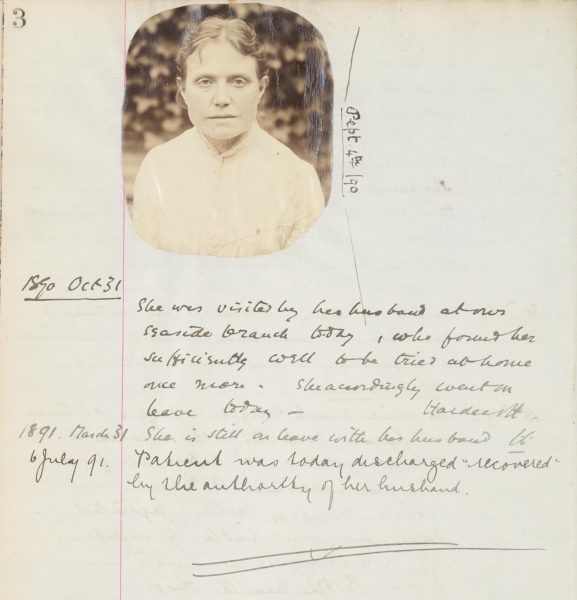
The Captain
Unlike Mary, other patients actively resisted those who were trying to capture their likeness. We know from the staff’s notes that Cuthbert Charles M., a Captain of the Royal Engineers (fig. 9), was bitterly discontent. He had contracted malaria while in India, and was now given to melancholia and erratic episodes of intense violence. He crafted many letters of complaint to the Superintendent. One of these (fig. 10) contains an accusation about a theft, which Charles illustrated with both a profile portrait of the alleged perpetrator and a small, inexplicable, sketch of a church. The patient’s case history of sullen discontent and delusion is inscribed around a poorly exposed, but nonetheless decoratively shaped, picture, which was pasted in the center of the page with the writing coursing around it, as if the image were being granted pride of place.
At first Charles M. seems to be leaning against a stone wall; but given the rippling shadows that hover next to him on the right, we can surmise that this is instead a paper backdrop tacked or taped up for the occasion. With his cuffed wrists tucked tightly into crossed arms, and his eyes closed, the Captain declares that while he may have agreed to stand before that creased paper backdrop, he is damned if he is going to meet the photographer’s gaze. As Jennifer Green-Lewis has pointed out, “closed eyes can be a form of resistance.”34 On his face is an expression that oscillates between a self-satisfied grin and a grimace. Not only is this man discontent; he wants the viewer to see that he is discontent. The slight smile and self-protective arms signal a performance of resistance, enacted expressly for a witness.
Despite what we see first: the rigidity of the subject’s body, and the arms pressed against his chest like a shield, closer study reveals that the Captain is much younger than his manner suggests. He is also well dressed in a suit of textured, striped wool, and perfectly starched cuffs. In general, the male patients at Holloway are more consistently attired in proper upper middle-class costume than the women are. One consequence of this propriety is that mental states are more easily masked; the suit, cravat, and collar become a form of camouflage. We see variations of middle-class masculinity under duress. In some pictures, the masculine body seems on the verge of collapse; in others, the socially appropriate male patient appears as a fortified carapace, impervious to the ebbs and flows of mental strain. While Mary C. had expressed a conviction that she was being “mesmerized,” her preternaturally intense study of the camera seems a quest to understand a force that she can sense, but not control. In contrast, Captain Charles experiences the camera’s and, presumably, the photographer’s presence as physical intrusions, in response to which he closes his eyes, covers his chest and stiffens the body inside that severely tailored suit.
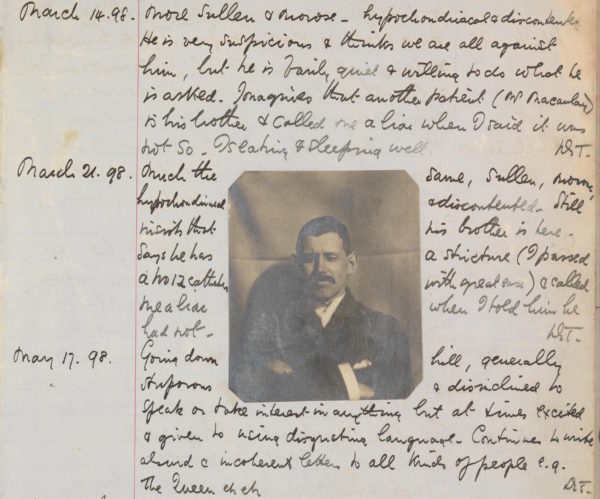
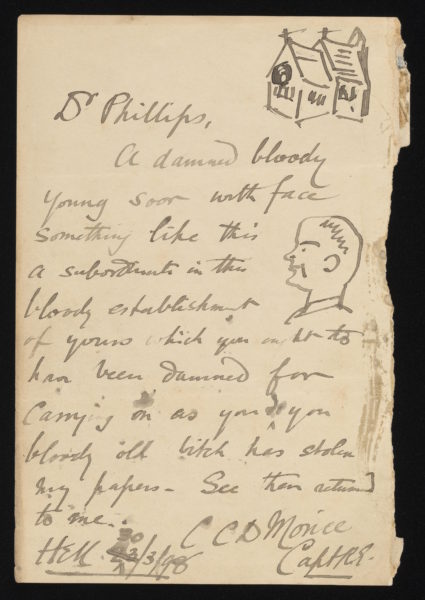
Julie P.
Some patients seem to have actively collaborated with their photographers. Julie P. first came to Holloway as a Voluntary Boarder but was later certified. According to the notes made upon admission, Julie was oppressed by “mental worry, and an inability to recognize anybody.” For the last several months, according to the staff notes, “she has not been in possession of her reason.” But the photograph we initially see pasted to the page is completely at odds with such a description (fig. 11a). In fact, Julie stands before Holloway as if it were her manor house, with no trace of the distractible behavior she apparently manifested upon admission. Her hair is swept into an elaborate cascade of curls atop her head. There are jewels in her ears. She is clearly corseted, as the curving, concave row of tiny buttons indicates. A lustrous stole encases and broadens her shoulders. Although her lowered hands are outside the margin of the picture, we can assume with confidence that they are demurely clasped together. Julie’s unusually pale eyes seem sharply focused, although they are directed out of the picture, as if she is knowingly offering her most advantageous side to the photographer.
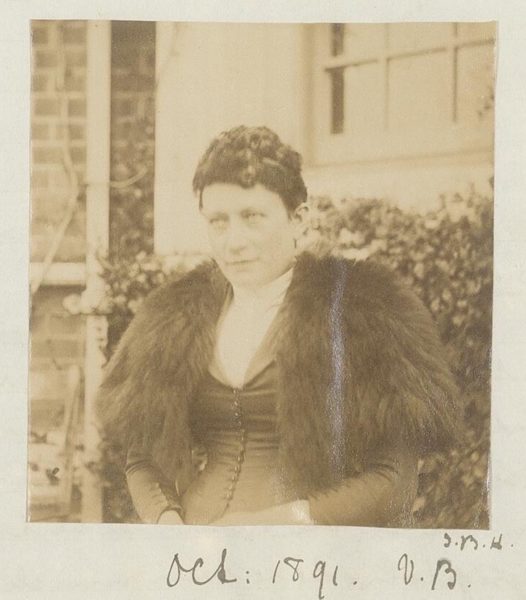
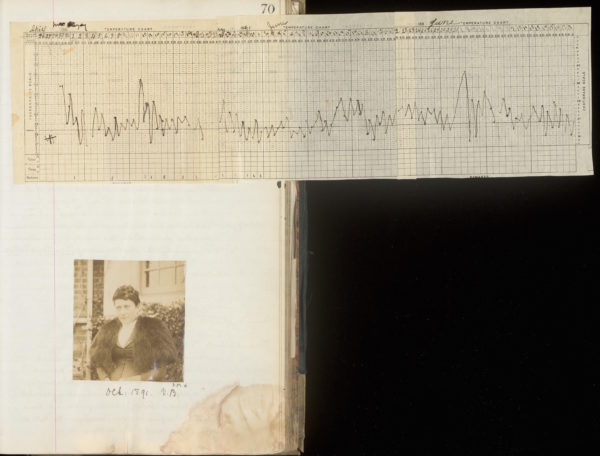
Pasted above Julie’s portrait as a lady of the manor is a piece of medical ephemera—a temperature chart that documents (fig. 11b) the spiking fever from which the patient suffered not only at the time of admission, but through much of her stay. Apparently, days passed before it was discovered that Julie was suffering from an open wound in her lower back that had never quite healed. The temperature chart can be unfolded and opens well beyond the page’s edge. Allowing the entire chart to be visible seems a deliberate gesture of transparency, a move towards supplying the “objective” medical evidence that might explain the young woman’s temporary loss of reason as described in the narrative, which seems grossly mismatched to the photograph. However, it turns out that the clinical chart is performing an act of concealment. Hidden directly underneath the fragile paper diagram, visible only when the chart is gently pulled away from the page, is an overexposed photograph of an emaciated, distressed young woman: Julie’s “before” picture, made shortly after admission, and dated “Spring 1891,” a photograph we are not initially allowed to see (fig. 12). Julie’s figure here is slightly blurred, as if her agitation cannot be stilled. Her head is tilted, and her mouth is half-opened, as if she is in the midst of some utterance; her eyes, so directed in the first photograph we saw, look wildly unfocused in this image. In addition, Julie’s hair looks both sparse and disheveled, and is pulled back gracelessly from her forehead. A narrow lace collar presses against the neck of an otherwise unadorned black dress. The woman in this photograph seems as bewildered and detached from her surroundings as one of Hugh Diamond’s patients. The picture of the elegant young matron we saw first was taken in October of the same year—effectively, the “after” photograph attesting to Julie’s improved health. Both photographs were taken by the same staff member, the only one who displayed a strong interest in photography: Dr. Jane Henderson.
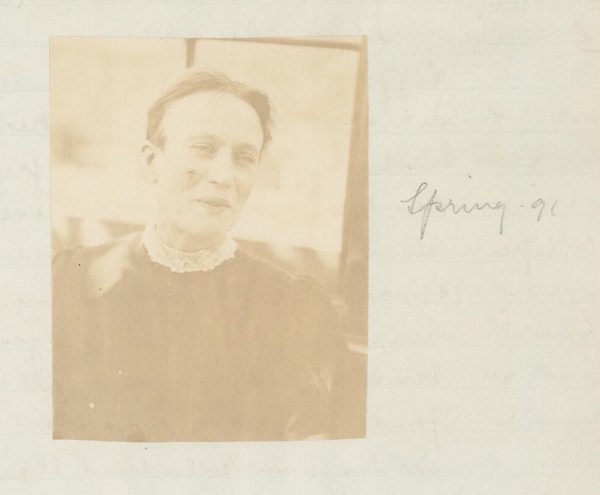
Jane Henderson was the very first woman doctor hired at Holloway, where she stayed for only two years. She seems to have taken a genuine pride in her photographs, as she initialed every one of them, and was virtually the only staff member who routinely made an explicit connection between a photograph and the symptoms described in the accompanying texts.35 (On the whole, her narratives appear longer and more nuanced than those of her contemporaries. She seems to have been a more patient listener.) When Jane Henderson left Holloway, she travelled to Paris, where she spent her time attending Dr. Charcot’s lectures at the Salpêtrière. She apparently did so with such enthusiasm and frequency that she published an admiring tribute about him shortly after his death in 1893 in a Glasgow newspaper.36 Jane Henderson may well have been familiar with the Nouvelle iconographie de la Salpêtrière—although she had not met Charcot before she came to Holloway. But her construction of exemplary moments in Julie P.’s life as a patient at Holloway suggests a very different approach towards medical photography, one that seems far more fluid than the neurologist whose work she so admired. If we assume that Dr. Henderson composed the page herself, masking the picture of a highly distressed subject with the temperature chart, effectively, she collaborated (or colluded?) with her patient to produce a curious amalgam of medical transparency and sleight of hand, in which Julie’s “after” photograph functions as the “evidence” of a kind of magic trick.
Timing
While the function of what are effectively Julie P.’s “before and after” photographs—the initial inaccessibility of the former notwithstanding—is relatively clear, the impetus for the timing of most of the casebook pictures is far less apparent. Some photographs were taken in the midst of treatment, weeks or months after admission, and are only intermittently related to the hand-written narratives that ebb around them. Under these circumstances, it is often difficult to assess whether the casebook image is meant to capture some evidence of the crisis that brought the patient to Holloway in the first place, or the resolution that allowed them to leave.
When was Alice S. photographed, for example (fig. 13)? Wary but engaged, she stands primly before us, with her head slightly tilted as if to remain alert to what the photographer is doing. Encased in an ensemble of oversized black sleeves and a high, tiered collar that completely covers her neck, she resembles a small, hatless witch. She appears to hold a small purse or handkerchief, whose almost perfectly balanced triangular shape reiterates the geometry of her form in its entirety. Her lacy apron would perhaps look more appropriate in a domestic setting, although it is also at odds with the near theatrical scale of her sleeves. The date of the picture, 27 June 1898, several days after admission, is written twice—once directly on the photograph, and again alongside it, as if to match the patient unequivocally to her representation. Admitted at age forty-six, the wife of a baker, Alice is a success story. She had been “slightly suicidal”—a behavior that continued at Holloway after admission. “All life is a trouble to her,” say the doctor’s notes, “she can settle into nothing.” Just weeks later, she improves, and by August, she “feels quite a different creature than she did when she came here,” as the notes put it. She is discharged on 24 August 1898, “by the authority of her husband.” At what point in her roughly two-month stay did she pose for this photograph? Before she put a stocking around her throat, in a documented suicide attempt? Or after? Is this a “typical” representation of her “disease,” which sounds like what we would call depression today, or an instance in which her black mood has been “corrected”—even if temporarily—for the camera?
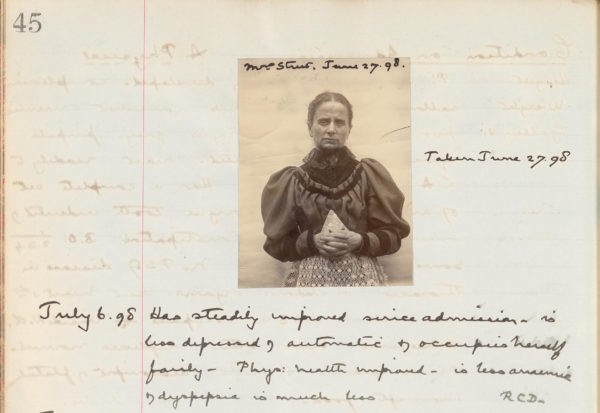
Temporality is both invoked and deflected in what initially appears to be a sequence of photographs of Agnes Alice S. (sometimes identified mistakenly in the casebooks as “Agnes Mary S.”), who was known as “Lottie.” Although two of the images are given approximate dates (“Spring 91” and “Oct. 91” respectively), they do not appear to accurately portray the behaviors and moods noted in the doctors’ narratives that are placed alongside them. The staff consistently describes Lottie’s behavior as oscillating between extreme agitation and stupor. The earliest of the photographs, taken a few months after her admission (fig. 14a) has the pallor of a faded daguerreotype, although enough of the image remains that we can spot Lottie sitting distractedly by a window, her eyes glazed, uninterested in the presence of the camera. The print seems to have been over-exposed initially, but it is also water-damaged. It can take a while to realize that Lottie is not alone. Two female attendants (the one with the lace-trimmed cap is likely a nurse) loom into the frame from the upper right and lower left respectively. The nurse on the right bends her head down so far that it seems to touch Lottie’s; the other attendant peers up to her from below, crowding Lottie’s body with an urgency that suggests that the possibility of physical restraint is hanging in the balance.37
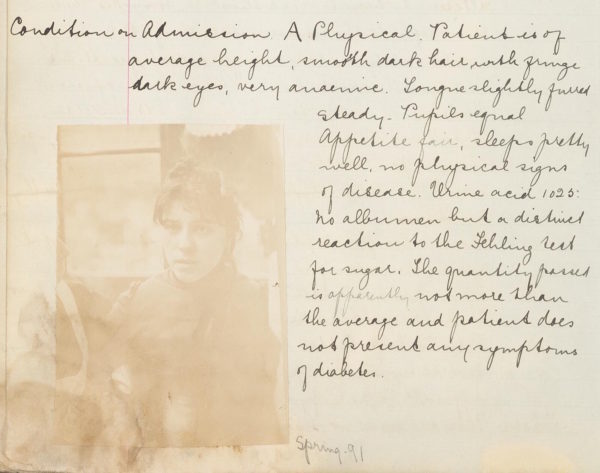
The next photo of the patient (fig. 14b), taken several months later, would seem to represent a woman whose responsiveness, and self-care, have improved. She is pictured without her caretakers, outdoors, rather than constrained inside. In this second picture, Lottie’s head is swiveled to the right and her gaze seems alert, as if she has spotted something compelling in the distance. Her hair is gathered neatly into a tightly wound topknot, and the mutton-sleeved coat she wears, with a high fur collar cradling her long neck, is quite fashionable. Separate the photograph from the casebook and she could be a young woman paused on the curb of a London street waiting to cross it. Twelve years pass before the third photograph appears (fig. 14c). By then, the staff’s narratives have been reduced to a laconic phrase or two, typically added only once a year. This last image has the studied informality of a snapshot. Despite the long interval between photographs, Lottie does not seem to have aged significantly. Although her brow is slightly furrowed and her eyes are cast down, the outdoor setting and signs of a breeze ruffling her hair suggest that she is standing in a field under the sun—she could be a young mother looking down at the child who plays by her feet.
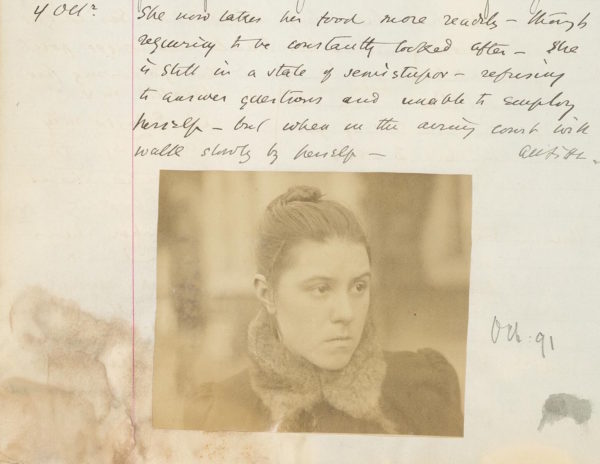
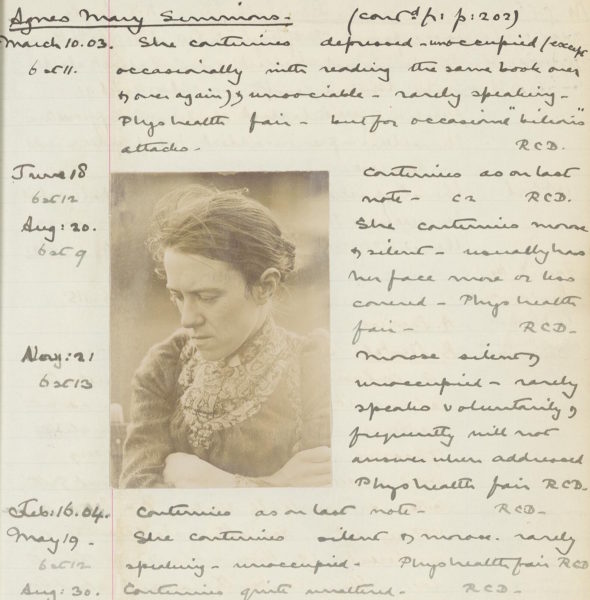
At first, the trio of Lottie’s photographs appear to provide a more “complete” narrative of her life than we customarily see in the casebooks, a perception initially reinforced by the presence of a letter she wrote to her mother, pleading to come home (fig. 15); and a “Caution as to Suicide” notice that she was given shortly after admission (fig. 16). We seem to have more information here than we usually do. But the written record refutes any trace of either narrative or pictorial logic. Although Lottie does not appear to get much older, these photographs were taken years apart, hardly an adequate representation of someone who spent so much of her life at Holloway. And the appropriate-looking, even relaxed, casebook portraits are in fact entirely at odds with Lottie’s actual behavior, which apparently grew more and more “stuperous” over the years.
Perhaps the pictures perform another function, whether intentionally or not: they suggest an idealized vision of the life that this young woman might have led, had her circumstances been different. The photographs “perform” a life that was not, in fact, possible for Lottie to lead. As such they act as a parallel fiction—Lottie stands in for an ordinary middle class young woman occupied in the events of her day. The infrequent notes on her continuing lack of progress trail off almost completely around 1907, at which time they apparently continue in another casebook, which is now lost. Unmarried women whose relations with their families were troubled (she had expressed a “violent hatred” towards her mother) tended to remain in Holloway for many years—hardly the resolution that Thomas Holloway had originally intended.
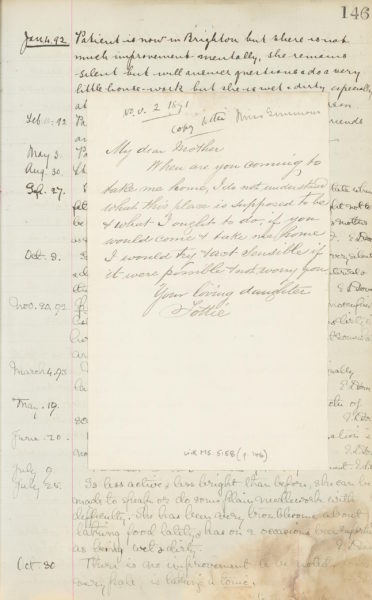
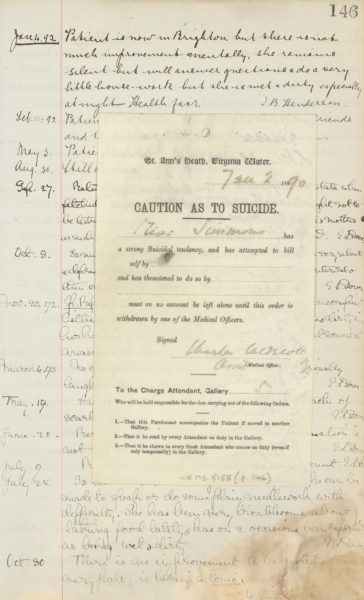
Text and Image
While Lottie’s history was all but detached from the pictures that purported to “illustrate” it, that is hardly the only disjunction between text and image in Holloway’s casebooks. In general, there is no systematic separation of image and text, as would be expected in a medical ledger. Sometimes, the two compete for visual authority directly on the page. In many instances, the doctors’ observations are inscribed around the photograph, as if the image is the primary object to which the text defers. Yet in other instances, notes or dates are written directly over the image, as if it is simply another equivalent, or even lesser, text. Captions to the photographs were exceedingly rare, as if the images themselves were self-explanatory; and indeed, this would have been in keeping with Hugh Diamond’s influential dictum that photography was the only language necessary. As he wrote in 1856, “The Photographer … needs in many cases no aid from any language of his own, but prefers rather to listen, with the pictures before him, to the silent but telling language of nature.”38
Apparently, Holloway’s are the first medical casebooks in which illustrations and case-notes were produced at roughly the same time, which makes the dissonance between them all the more noteworthy. They represent a marriage of word and image that is at times not unlike the composition of certain illustrated medieval manuscripts, in which the marginalia acted as a counter-text commenting upon, elaborating, but at times contradicting what the inscribed text, and its accompanying illuminations, related. The Holloway casebooks offer a medicalized, secular version of what medievalist Michel Camille referred to as the disputatio.39 Doctors’ notes vie with the patients’ own accounts, which are often contradicted, in turn, by the comments of the relatives who brought them to Holloway, and then finally, by the photographs themselves.
A crucial part of Holloway’s practice was to retain all the test results, letters, and drawings executed by or pertaining to the patients themselves. We have already seen Lottie’s letter to her mother and her “Caution as to Suicide” notice (which were unfortunately quite common) as well as Captain Charles’s rant to the Superintendent. Many female patients wrote to the lost loves whose abandonment had reportedly precipitated their “attacks”; many male patients, like the Captain, wrote notes to the Superintendent, accusing a staff member or another patient of theft or an act of violence. Quite a few Holloway residents, both male and female, penned missives to the Queen, whose country residence, Windsor Castle, was nearby. And of course there were a number of death notices. Holloway’s medical casebooks brim with so much material “evidence” that at times they seem to mimic the features of a family scrapbook.
Performing Sanity
The desired relationship between text and image at Holloway remains difficult to assess, and inevitably shifted with time, and different administrations (although Rees Philipps presided as Superintendent for over twenty years). On one hand, the photographs were clearly not straightforward clinical records, laid out on the page expressly to support a text. But neither were they conventional portraits that could stand alone without a text. The ambiguities are distilled in a series of pictures in which patients seem to perform expressly for the camera. Reportedly violent, delusional patients sit quietly, even ingratiatingly, for the photographer; and patients whose photographs suggest a despair beyond intervention are reported as cheerful and occupied, and are discharged “relieved” or even “recovered,” as the notes attest.
Albert W. (fig. 17), admitted in February of 1902, for example, seems the picture of upper middle class, masculine propriety and restraint—as did most of the men who agreed to be photographed. Yet the case-notes above his photograph (which happens to be glued directly on top of the notes themselves) read: “His appearance and manner are insane; he is eccentric and solitary, irritable, violent and rapid in his movements and is very passionate when opposed.” The patient Arthur T. (fig. 18) affects amused tolerance for the photographer. He is handsome and animated, indulging the photographer with a carefully casual pose, as if he is sitting in a professional London studio, rather than before a crudely hung, paper backdrop. Perhaps he imagines that he is looking at the Queen, to whom he had penned several letters. George Howard M. (fig. 19), a mining engineer, was photographed in June of 1903. Despite a certain vacancy in his eyes, he appears well groomed and presentable. Decorous appearance notwithstanding, the most pronounced theme within George M.’s case-notes is his homicidal violence.
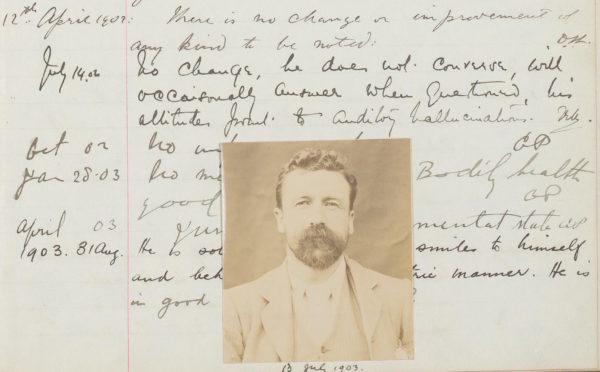
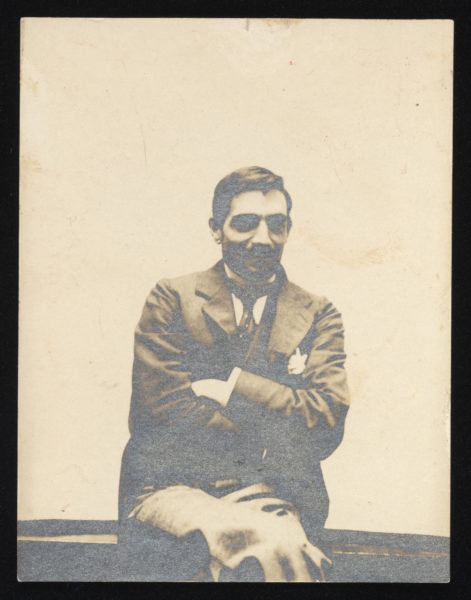
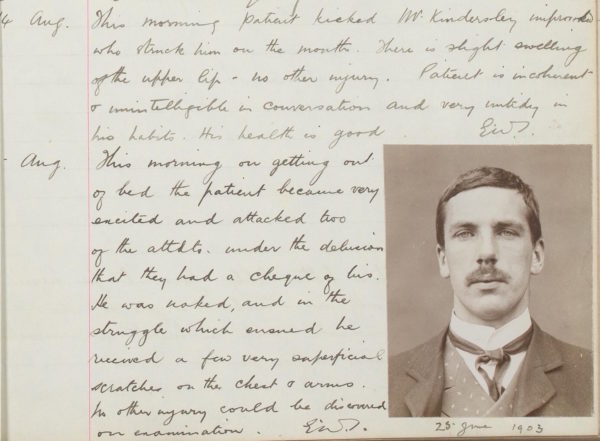
That appearances can deceive, or at least re-direct one’s impressions, seems especially pertinent in the photograph of Herbert D., a thirty-seven-year-old brewer’s clerk (fig. 20). The photograph is larger than most casebook images, and was inserted loosely into the pages, rather than being fixed permanently. Herbert sits on a makeshift bench, before that wrinkled paper backdrop, with the expansive masculine authority of Jean Auguste Dominique Ingres’ Portrait of Monsieur Bertin (1832). Indeed, Herbert himself could almost be an educated man of leisure, with his watch fob, high collar, cravat, and fluffed-out handkerchief. He looks confident, at ease in what appears to be a wool suit and vest, with a collar and cravat. The way he tucks his hands in his pockets suggests a gesture of leisurely satisfaction, rather than shyness or restraint. Herman seems to preside comfortably over the photographer and his imagined audience, rather than simply sitting passively to be observed. Yet, the case-notes on the preceding page emphasize that Herman was solitary, suspicious, and reserved, and spent most of his time answering the voices of his auditory hallucinations. Perhaps he could “perform” sanity for at least the time it took to set up the paper backdrop and the bare wooden bench. Through the photograph he might reclaim—if only temporarily—a “self” that was no longer on display in the wider world. In collaboration with the photographer, Herman effectively staged the picture of a self-possessed, sane man at ease in the world, a performance now memorialized in a medical document that was unlikely to be seen by more than a handful of people.
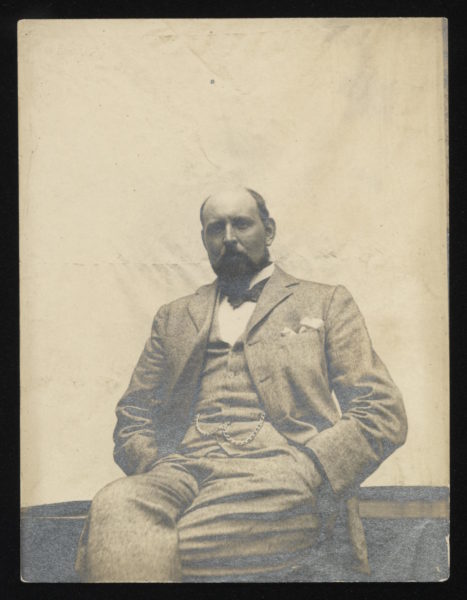
At other times, the recurrence of a patient’s photograph tells a story more eloquently than any text can. Herbert A., age twenty-two and single (fig. 21), is described as a pianoforte manufacturer. He seems perhaps a bit arrogant, faintly unyielding, with his shoulders squared and his head faintly tipped back. He manages to command his small area of the page. This imagined “Prince of Italy,” son of the King, which he believed himself to be, seems to be enacting his supposedly elevated status. His body is pressed against the chair back, envisioned from below, an angle that monumentalizes him. He sits agreeably enough, as if he is accustomed to being looked at, although he does not deign to acknowledge the photographer. The decorative flourish added beneath the centered photograph and accompanying texts becomes a frame for a kind of triptych—with Herbert’s image floating like a donor portrait between the now-honorific words penned on 15 July: “Discharged” on the left; and “Recovered” on the right. Unfortunately, Herbert would not remain recovered; he would return repeatedly in the years to come, the victim of increasingly frequent manic episodes. His photograph resurfaces over and over like a reproach to the sanatorium that failed him.
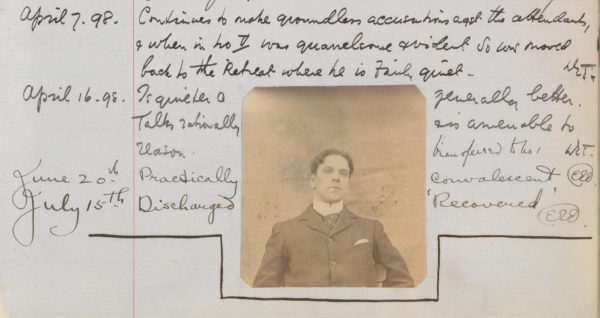
The Page as Pictorial Field
While there are narrative disjunctions between image and text, there are also unexpected visual juxtapositions that generate a dialogue between them, activating the entire visual field of the casebook page. Maude B. (fig. 22), age twenty-seven, was a governess whose engagement was broken, apparently because of her reluctance to leave her teaching career, to which her fiancé objected. The casebook notes editorialize on this matter, adding that the “engagement seems to have been broken several times mainly owing to her capriciousness.” The doctor’s notes cite a phrase she utters over and over: “I am a blank.” The empty space of the casebook page, whether or not it was intended to remain unfilled, produces an almost poetic dialogue between her image and her utterance. Perhaps the patient believes, like a young child, that if she closes her eyes, no one will see her. With eyes shut, her portrait is reminiscent of the criminals of the 1870s who squeezed their eyelids tightly when they were photographed by their arresting officers, thus defiantly foiling attempts at the public’s recognition.40 Perhaps Maude’s refusal to disclose her features fully was a form of resistance that preserved at least a trace of her own.
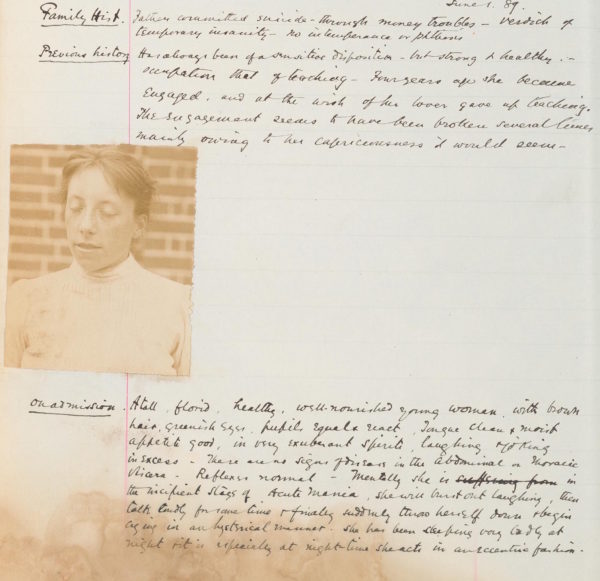
At times, the arrangement of the casebook photograph on the page seems not only provocative but performative. For example, the first photograph we see of Eleanora Susannah S. (fig. 23a), has been slashed to fit the casebook’s narrow margin. Her diagnosis is “melancholia with stupor,” and her posture is erect to the point of panic. Her hands seem gnarled, gripping something that cannot be identified. She is a widow at only thirty-one years old, although she looks much older. Six months later, she is reported to be cheerful and occupied, and has a fair amount of initiative, as well as an ability to convey emotion appropriately. She is discharged, recovered, in July. In the photograph pasted near this more optimistic report (fig. 23b), also taken at Holloway, Eleanora Susannah is fuller faced, almost smiling above a broad white collar and fluffy bow, looking directly into the camera without strain. Through a few pages of the casebook, which collapse together the trials of several months, her image has been transmuted from the narrowed marginal representation of an impossibly strained body and grim visage to this quite pleasant portrait, pasted onto the page proper, not its margins, and shaped into the oval typical of a sentimental family souvenir. It is as if, with health restored, Eleanora Susannah now deserves a genuine portrait. Lora B.’s, in contrast, was faceted like an old tintype (fig. 24), cut into an octagon before being pasted into the casebook. The archaic form of her photograph seems in tune with her relatively old-fashioned dress, and severely drawn back hair.

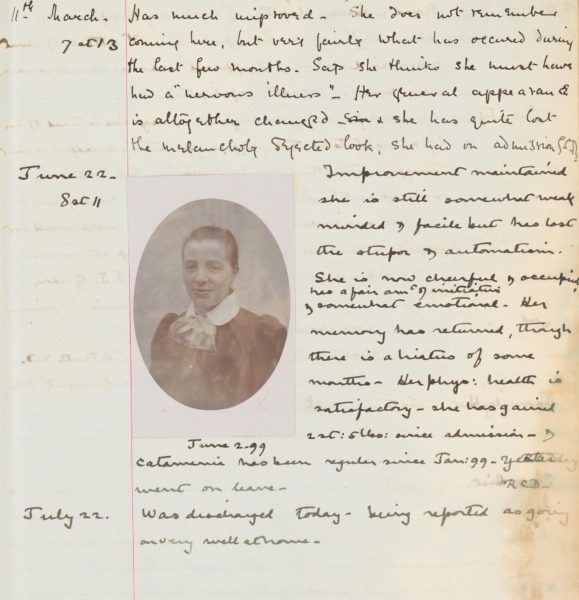
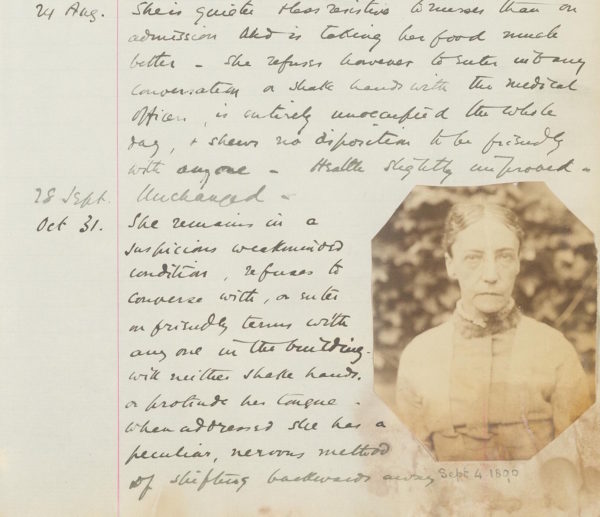
Another patient, Constance B., is presented in three distinct formats in her casebook, each of which suggests not only a different behavior of an individual patient, but also a different conception of image-making. In the first photograph we see (fig. 25a), Constance is outdoors, her wispy, bound hair irradiated by the sun. But her eyes are closed, and her head seems wobbly on her neck, as if she is about to tilt forward under the force of the light, and perhaps the imagined violation of scrutiny. A few pages later, there are two photographs side by side. The one on the left (fig. 25b) has the matter-of-fact scale and proportion of a nineteenth-century identity card, along with some of the conventions of the studio portrait. Constance’s hair is pulled back with fierce restraint into a tiny topknot; the sleeves of her jacket appear to swell out as we observe them, and the colossal buttons on her jacket seem like eyes punctuating a large, amorphous face. It is as if the costume itself is posing, rather than the young woman who inhabits it. The narrow photograph pasted next to this is far more unsettling (fig. 25c). Constance is dressed like a young girl off to a Sunday picnic—she wears a blouse, a walking skirt, and a rather extravagantly decorated straw hat, completed by a large bow tucked under her chin. But she perches on a stairway like a rag doll being held up by invisible wires, her arms hanging slackly by her side. There is a rare caption beside the photograph that says “usual attitude, Arms falling to side.” Constance’s aberrant posture is reminiscent of one of Charcot’s full-body visualizations of pathology.41 The patient is apparently older than she looks, and had suffered a bicycle accident some weeks ago. Since then, she says that devils have taken possession of her, that her friends are trying to poison her. She needs to be tended like a young child, crooning to herself in meaningless cadences. Constance’s history as “neurotic,” even “hysterical,” is invoked repeatedly, while the recent accident in which she may well have suffered a serious head injury is only fleetingly mentioned. Her history trails off into other casebooks, years into the future, until she is discharged to the Manor Asylum in Epsom after pushing a hairpin down her throat. There are no other photographs of her.
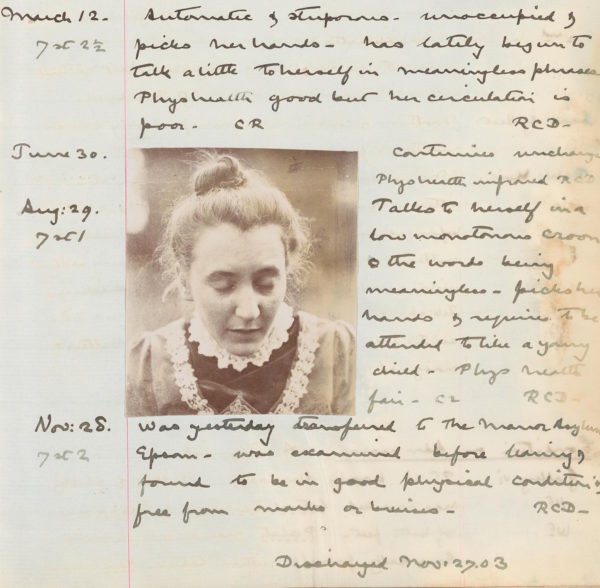
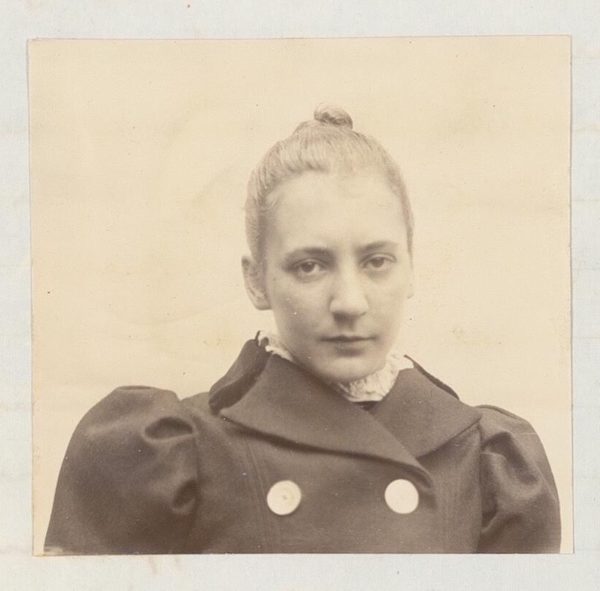
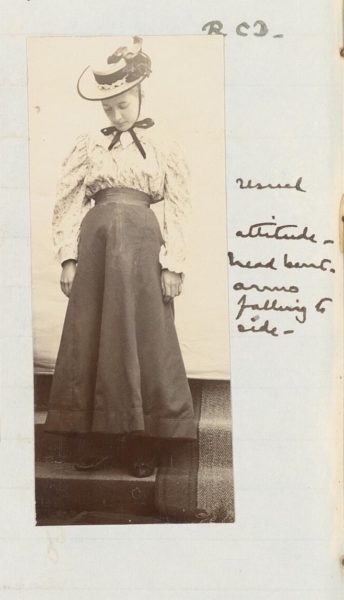
Arthur B., (fig. 26), age twenty-six, initially seems to have a more optimistic future ahead of him, although unfortunately he will stay at Holloway for years to come. He is a single clerk, and although he appears energetic and alert, he has been suffering from depression. His bust-length portrait is centered at the very top of an otherwise blank page. His missing body becomes a kind of imagined column on which sits the head that nearly fills the photograph, which has been cropped to its proportions. Arthur’s curly hair, high collar, cravat, and above all the long, waxed moustache, rivet attention to his head, which further intensifies our awareness of his absent body. His dark features atop that empty space produce an effect not unlike that of an Egyptian Fayum mummy portrait in which the body of the deceased has effectively disappeared into its wrappings, the only trace of human presence the stark, beautiful oval of the painted face.42
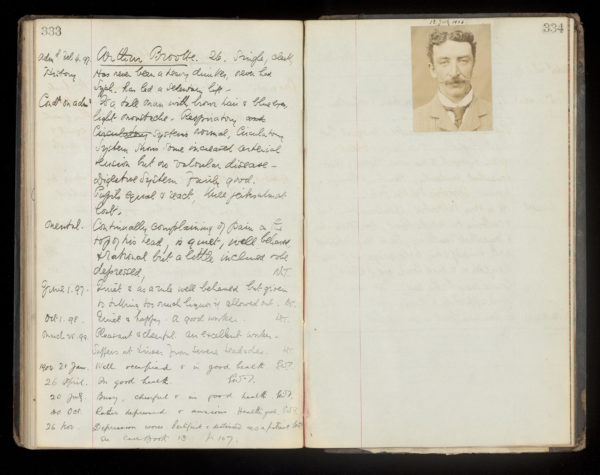
From the point of view of class, Alfred S. (fig. 27a) offers a direct contrast to Arthur B. Although Holloway was indeed mostly filled with people from the upper middle and middle classes, some patients less fortunate were occasionally admitted. Eventually, many of them were employed at the sanatorium. Alfred S. was a twenty-two-year-old tenant farmer, admitted in May of 1898. His precipitating attack was reported to be caused by a combination of “influenza” and the “strains of responsibility.” The first photograph we see, small and overexposed, was taken about a month after admission; the date is written right over the picture. Alfred’s body is layered with shapeless work garments, which nearly slide off his shoulders as he sits, vacantly, as if unconscious of the photographer’s presence. A few pages later, a slightly larger, more formal photograph is loosely inserted into the casebook (fig. 27b), likely taken close to the time of his discharge. Alfred’s body, centered for the camera, now fills over half the frame. The wool suit he wears (in the month of August) is likely not his own. The case-notes tell us that he worked steadily on the grounds at Holloway throughout his stay, and by the summer, “he has now attained to almost his normal mental condition, which is not very brilliant.” The notes add: “He is grateful to us for his recovery.” What is perhaps most revelatory about this photograph is the gap between the crookedly hung paper backdrop and the flowered wallpaper behind it—the “real” Holloway décor that is barely masked by the provisional, “objectifying” length of paper. Alfred is in limbo, stranded between different worlds—of class, geography, and conceptions of illness and health. And so is his photograph, poised as if somewhere between, or outside, the worlds of vernacular and art photography.
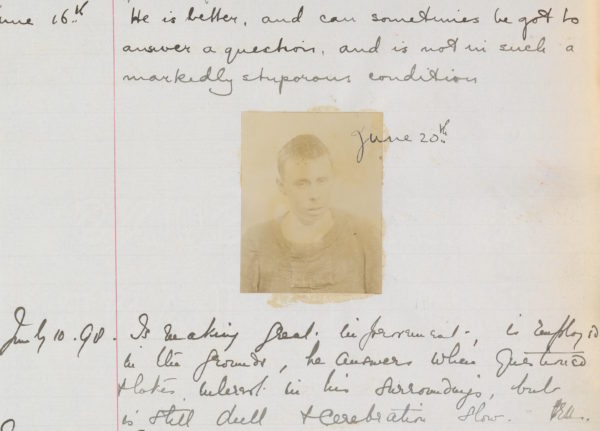
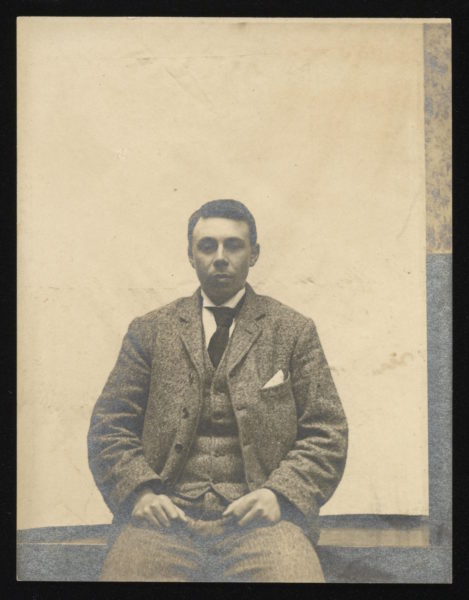
There are occasional oddities in the casebooks that cannot be fully accounted for—either aesthetically or medically. Some patients’ photographs are paired with narratives whose juxtaposition is not simply obscure, but downright disturbing. Often these particular case notes contain highly judgmental observations that go beyond the need to record revealing symptoms. For example, the first casebook contains a picture of a comfortably seated, grandmotherly woman, complete with apron and lace cap, who seems to be looking kindly at her viewer. Marie P. (fig. 28) was a Prussian-born former governess, who was consistently described by the staff as a proud, haughty woman, and who frequently expressed disdain for both her “subjects” (the other patients) and the doctors who questioned her. Her caretakers seemed to bitterly resent her attitude, although they remained somewhat intimidated by her. The casebook photograph that accompanies the narrative about her hauteur presents her as the object of ridicule: the large black cat spread out across her lap was notoriously fat (partially because she overfed him), although she was consumed with worry over his imagined starvation, as well as his heart disease. Here, the photographer has put Marie P. in her place, so to speak: the highly educated governess to the upper classes has been reduced to a foolish, sentimental domestic servant.
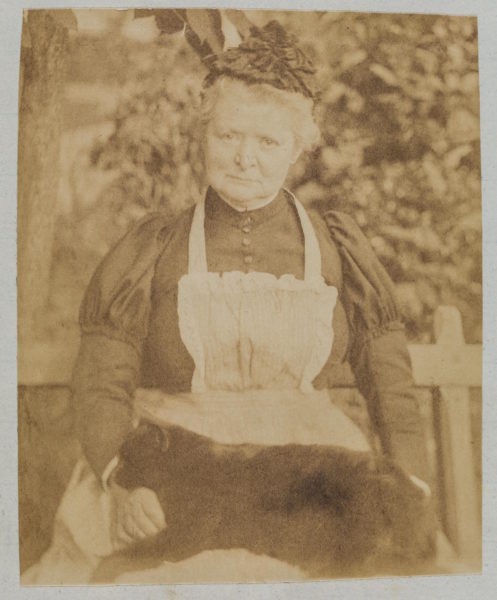
The patient Jane S. (fig. 29) was suffering terribly from mania caused by a dangerous post-childbirth infection called puerperal fever. She is delusional, violent towards others, self-destructive, and refuses to wear her clothing. Yet, perhaps because she is a “small, delicate-looking woman, sparely nourished with an abundance of dark brown hair, green eyes with dark lashes,” as the case notes tell us, she has been staged for the photograph as a kind of fashionable mannequin. The vacancy in her eyes suggests that it was not her decision to be pictured at all, let alone to be dressed in the elegant but restrained fashion of an Oxford student on an outing.43
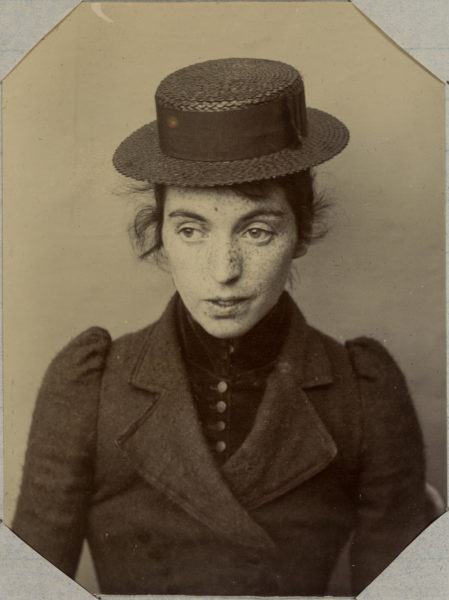
Conclusion
Sometime around 1910, photographs began to disappear from the casebooks. Confusion about the role of photography at Holloway seems to have intensified, rather than dissipated, as two last photographs demonstrate. Neither of these shows the patient as they would have appeared at Holloway. One of the latest casebook images is—one is tempted to say—a portrait of a cirrhotic liver (fig. 30a), sensitively lit and centered on the page: the material trace of a female patient, Sylvia T., who had died of alcoholism. A letter accompanies the photograph (fig. 30b), written by her present doctor to her former physician, affirming that there was nothing that either of them could have done. While the patient’s body has disappeared, the diseased organ seems presented as material proof of the doctors’ innocence in Sylvia T.’s inevitable demise—evidence that would presumably be interpretable only to other medical experts. For all intents and purposes, the person of Sylvia T. is gone.
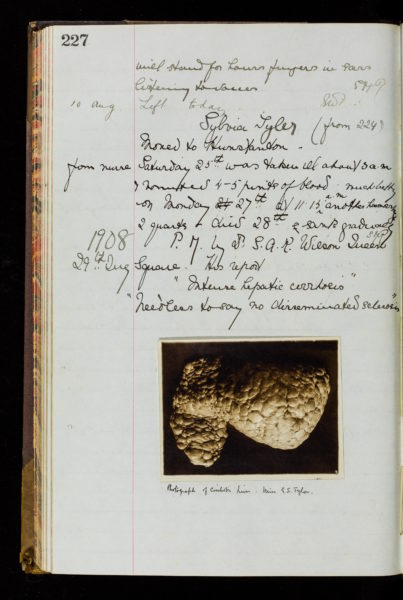
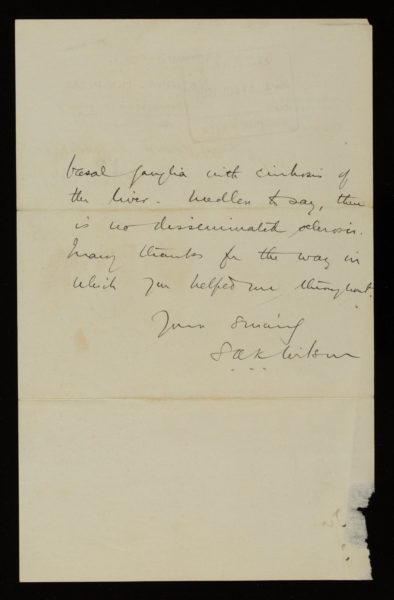
Another of the late photographs in the casebooks was not made at Holloway at all, although it does portray a former patient. In April of 1906, a young woman named Corisande C. was admitted to Holloway. She was single, twenty-six years of age, and had no occupation. She had an interest in dancing and singing, voiced in a letter—pinned still to the casebook pages—to a doctor who had ignored her musical aspirations. Evidently, the lack of encouragement Corisande received at Holloway did not deter her from a successful career as a “classical dancer.” The photograph inserted into the casebook (fig. 31), torn from a contemporary journal, tells us that “Miss Corisande has recently appeared at the Aeolian Hall.” Her bejeweled, risqué top and what seem to be harem pants affirm that she is costumed as some kind of Orientalist “exotic.” The stark sensuality of her reclining pose and revealing dress are at odds with her downcast eyes. Perhaps for the pages of this London illustrated journal (whose name we no longer have), she became adept at resisting the intrusion of the camera. Although Corisande was not photographed while at Holloway (or listened to particularly closely), her confident, professionalized femininity apparently testifies to the success of Holloway’s “cure.”
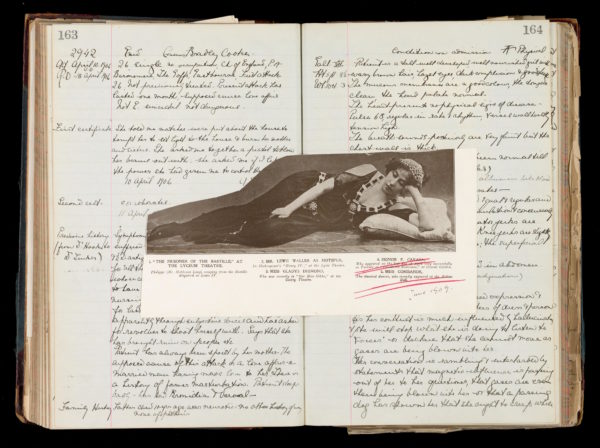
Sylvia’s cirrhotic liver and the trappings of Corisande’s post-Holloway career suggest the vast range and kinds of questions that can be posed about the casebook photographs of the sanatorium. My essay here has been intended as an introduction to the complexity and challenges of this difficult, but incomparably rich, visual, material archive. A variety of methods and conceptions about image-making and its intersection with materiality will need to be developed to extract everything we can about what these photographs reveal about the intersection of medicine, gender, history, and image-making around the turn of the twentieth century. While we are enormously privileged to be able to access all the casebook photographs from the online catalogue of the Wellcome Library, I urge anyone who is interested in studying them to see these folios in person in London, and in Woking, Surrey: to turn the pages of a casebook, consider a selection of the photographs that lie within them, note the “cautions to suicide,” the drawings, the test results, the death notices, the letters to the Queen or to former, or imagined, lovers. There is even an X-ray of a patient’s broken femur slipped into the pages. Reading the case histories and studying the photographs and all the ephemera attached to the pages is difficult, sometimes heartbreaking, work. But an intensive consideration of these photographs, in tandem with the histories they accompany, offers these long-departed subjects a version of the audience they imagined when they looked into, or even away from, the camera.
Notes
Finally, my biggest debt is to Julian Pooley, the Public Services and Engagement Manager of the Surrey History Centre in Woking, who introduced me to the very first Holloway casebook, and has educated me about the myriad ways in which historic medical records have survived—and been lost. My hope is that Mr. Pooley someday publishes his own narrative about how he and his colleagues drove around Surrey, rescuing hundreds of medical records that were on the verge of being abandoned, or had already been left behind for insects and rodents to infest them, and squatters to burn them as fuel. It is a fascinating story that needs to be told.
Through the generosity of the Wellcome Library, all surviving records are also downloaded, courtesy of the Wellcome Library.
All of the images from the Holloway Casebooks were scanned by Lini Radhakrishnan from the Wellcome Library’s Site: http://wellcomelibrary.org/collections/digital-collections/mental-healthcare/holloway-sanatorium/
The site includes images of the casebooks in the Wellcome Library’s own collection, as well as those in the collection of the Surrey History Centre, Woking, England. With the exceptions of Figures 4, 5, 28, 29, and 30, all images are from the Wellcome’s own casebooks. Kind permission has been given by the Surrey History Centre, Woking, Surrey, to reproduce the images in Figures 4, 5, 28, 29, and 30. Creative Commons makes it possible to make these images available, as “Attribution-NonCommercial 4.0, International” (CC BY-NC 4.0).
Introduction
Nearly two decades ago, photo historian Douglas Nickel observed that traditional art history had not yet developed the tools for handling non-art photographs.1 In many ways, much progress has been made since 2001: vernacular photographs of every kind have become worthy objects of study for scholars and critics—not only within visual culture, but in history, sociology, anthropology, and literary and cultural studies. In fact, these days, as Nickel himself has pointed out, studies of vernacular photographs outpace the production of monographic books about “fine art photographers.”2
However, it remains difficult for art historians to build an interpretative model that takes full measure of the visual subtleties of non-art photographs—including their unexpected aspirations towards the aesthetic—without slighting the historical and social conditions in which they were produced.3 With that challenge in mind, I consider here those very aspirations, as they surface repeatedly in a group of “medical portraits”: casebook photographs of patients made between 1885 and 1916 at the Holloway Sanatorium in St. Ann’s Heath, Virginia Water, Surrey, England (fig. 1). My intention is to offer the beginnings of a method that might help us both identify, and extract meaning from, the aspects of the images that cannot be accounted for by the conventions of medical or scientific representation. In so doing, I recognize that as objects of study these photographs cannot be detached from the entangled motivations that shaped their production, or the material conditions to which they remain bound.

To cite just an obvious departure from institutional convention, the dry-plate paper photographs produced of about a third of the patients at Holloway were scissored into various shapes—some more ornamental than others—and glued, pinned, and tucked into carefully incised corners, or loosely inserted into the pages of large, leather-bound casebooks. These folios contained the staff’s narratives of their patients’ case histories, which were inscribed upon admission in the following order: name, religion, occupation, marital status, number of children (if any) medical and family history, and the date and duration of the “precipitating incident” that had prompted the patients’ relatives or doctors to bring them to Holloway in the first place.
Holloway was not an ordinary nineteenth-century insane asylum; it was a “benevolent asylum for the mentally afflicted of the middle classes.”4 Thomas Holloway, the original founder, a highly successful merchant of medicinals looking for a salutary way to distribute his inheritance, was inspired to build such a sanctuary by a speech delivered by Lord Shaftesbury, the liberal MP and philanthropist who pointed out that the middle and upper-middle classes were under-served populations: too well off for the pauper asylum, yet not wealthy enough to be tended at home by servants and a shamed if compliant family.5 The lavishly decorated, beautifully landscaped Gothic revival structure by William Crossland was erected on twenty-two acres of rolling hills on St. Ann’s Heath, Virginia Water, Surrey, and easily reached by rail from London (fig. 2a).6 Holloway opened to much fanfare in 1885, at a ceremony attended by the Duke and Duchess of Wales. The sanatorium was originally imagined “for the unfortunate student who has overdone cramming for some public examination, for the over-worked barrister or clergyman, for those whose minds are filled with illusions on account of domestic troubles or bereavements.”7 About a quarter of the patients admitted were “Voluntary Boarders,” who desired an escape from the strains of life, and could afford to admit themselves without being “certified.” They were allowed not only to roam the grounds, but also to visit the neighboring village, without supervision. Eventually about half of the VBs, as they were called, were certified and admitted to Holloway, with mixed results. Others began as certified patients and decided to stay on as Voluntary Boarders after they had officially been pronounced “recovered.”8



The interiors of the “benevolent asylum” were painstakingly decorated and beautifully furnished; Crossland’s Gothic revival style featured lofty, arched ceilings and hand-stenciled foyers (fig 2b, fig 2c). There were individual villas for visiting families who wished to bring their servants. In the words of George Martin-Holloway, the brother-in-law of Thomas (who died before the plan could be fully realized), “a cultivated person whose mind is affected will never be cured if surrounded by vulgar accessories.” The monumental stone entryway, for example, was brightly gilded, because otherwise the cold grey “would sit heavily on a mind diseased.”9
The emphasis at Holloway was on integrating the patients back into the lives they had left behind. Thus, myriad conventional upper middle-class activities were offered. There were cricket games, dances, theatricals, and strolls around the grounds, even the possibility of riding one’s own horse, which could be stabled on the grounds. Since the majority of the patients were from well-off, educated families, the most advanced treatments and the newest drugs were expected to be utilized (electrotherapy, exercise, digitalis, bromide, hypodermic morphia and purgatives were among the most favored).10 The sleeping quarters of patients were segregated by gender—although spaces such as the dining room and parlors were available to both male and female patients who demonstrated appropriate social behavior. The casebooks were organized by gender, and separate folios were kept for Voluntary Boarders, although the narratives in these are far more rudimentary, and the photographs few.
The Shadow Archive
Over thirty years ago, Allan Sekula famously characterized the vast compendium of nineteenth-century photographs of “the poor, the diseased, the insane, the criminal, the nonwhite, the female” as “the shadow archive.” According to Sekula, this archive stood as the antithesis to the imagery of the wealthy and celebrated, an opposition that he distilled as “the honorific and repressive poles of portrait practice.”11 Sekula was largely correct. Most photographs that comprise the taxonomies of the guilty, the insane, and the deviant of these years did generally conform to roughly the same format: a rectangular, occasionally square, image of a frontal or profile view of a bust-length figure, whose face betrayed little or no affect. In fact, this very type of image was employed around 1900 at an institution just a few miles away from Holloway: the Ewell Epileptic Colony (later St. Ebba’s Hospital) in Surrey (fig. 3). At Ewell, a mug-shot like view of each patient was taken at the time of admission, and pasted at the top of the casebook page, with the pertinent medical history written directly below. Both the timing of the image and its use as an exemplary illustration of symptoms described in the narrative were straightforward, as was the organization of the narrative itself.

At Holloway, only some of the patients were pictured—no record of an organizing principle for determining how they would be identified has emerged. We do know that the pictures we have represent only the patients who agreed to be photographed. The timing of this process was unpredictable, and could range from days or even months after admission to shortly before discharge. In fact, photographs could be taken anytime within the patient’s stay, which lasted anywhere from a few days to decades—a duration that went against the express wishes of Thomas Holloway, who had intended that no patient should remain for more than six months.12
Aside from the fact that Holloway’s casebook photographs were cut into a variety of shapes, the patients themselves were featured in a range of poses, facial expressions, and manners of address to the camera. We see everything from a blank stare or a knowing sidelong glance, to an intensely searching gaze that appears to be reaching through the camera lens, as if to collapse the physical distance between the subject and the photographer. The pictures were produced by collective authorship, by largely anonymous staff members who sporadically initialed the images they made. On a number of occasions, multiple patients would be photographed on the same date, and in roughly the same format, suggesting that some of the work was done by itinerant photographers who would have been paid by the day.13
The very first Holloway casebook (1885–1897), dedicated to female patients, which I have written about elsewhere, includes some rather stunning anomalies in the history of medical photography.14 Not only are there a number of group portraits in this folio (fig. 4a and fig. 4b), the casebook also includes single-figure images of fashionable women patients that betray not a single trace of their institutional location (fig. 5) nor any sign of the presumed mental strain or deviant behavior that precipitated their admission to Holloway.
The group portraits in the first casebook were by and large composed of women whose histories were replete with accounts of their anti-social behavior. The case histories attest that at least some of the subjects were averse even to rising from bed in the morning, let alone getting properly dressed up to be photographed. None of the women pictured in either fig. 4a or fig. 4b were known to be particularly communicative—with either the staff or the other patients. Yet here they are together, not unlike relatives at a family reunion who do not know each other well, although they share a certain lineage. There are signs of deviance (anomalies of gaze or pose), but they are not obvious. The variations in class position—for Holloway did accept some patients from workhouses and public hospitals—are more overt and conveyed by the subjects’ costumes, which range from feather-trimmed coats and fur muffs to plain work jackets and skirts made of visibly coarse fabric. In the single-figure photographs the subjects use the exterior colonnade of Holloway as a veritable stage for their skills as elegant hostesses, which have presumably remained undiminished during their stay. Maria W. (fig. 5), in fact, has styled herself as a fashion plate, a perception reinforced not only by her idiosyncratic costume, but by a silhouetted pose that could have been lifted from a copy of La Mode illustrée.



Objectivity: Variations on a Theme
As Peter Galison and Lorraine Daston have pointed out, “policing objectivity” during the nineteenth century demanded that the scientific photographer renounce both theorizing and aestheticizing.15 The Holloway images appear to violate both prohibitions, in ways that are difficult to class. They neither fully embrace the aesthetic nor do they unconditionally repudiate the objective, veering between a kind of idiosyncratic, suggestive portraiture and a systematically unsystematic documentation. In their structure, function, and manner of presentation these photographs enact the very tensions that emerge when the boundaries between the objective and aesthetic are assumed rhetorically, but visually stretched to breaking.
At first glance, insisting on the relevance of aesthetics to the Holloway casebook photographs may seem profoundly misguided. As material objects, the pictures are, literally, rough around the edges: crudities of lighting, exposure, framing, and presentation abound. For the most part, the settings for the patients’ portraits seem to have been improvised. Despite the photogenic, decorative surfaces that were abundant at Holloway—hand-stenciled walls, carved architectural details, and ornamental fireplaces—the backgrounds that frame the subjects are at times distractingly shabby. Perhaps the relative lack of visual finesse was deliberate, a self-conscious affirmation of the medical photograph’s status as a scientific, non-art object—an expression of what Martin Kemp has identified as a “rhetoric of objectivity.”16
Yet the sheer variety of forms and presentational strategies that recur in these casebooks serve no obvious function within such a rhetoric. Some pictures are marginal strips cut to fit into the narrowest possible space, clearly subordinate to the “primary” text of the case-notes. Others are larger, square and flat, emulating the proportions of an identity card, and are pasted firmly into the center of the casebook page, “framed” by the text. Still others mime the conventions of a studio family portrait, or a sentimental album picture, having been shaped into an oval. A number of patients’ images are faceted like old tintypes; and occasionally a picture has the ghostliness of a one-of-a-kind daguerreotype. Although the photographs were, in principle, reproducible, as any dry plate photo would be, their context is singular, and impossible to recreate. The sheer variety of the pictures’ material properties and their surrounds, absent any prevailing logic to account for them, lends each of these photographs the potency of an original—precisely the opposite of the monotony we have come to expect of institutional photography.
And while the collective authors of these pictures may not have employed the more obvious trappings of the late nineteenth-century portrait studio—fur rugs, free standing columns, painted backdrops—they did consistently employ schematic, improvised variants of its signature conventions. In most cases there was at least a modest background, a self-conscious pose, deliberate framing, and a visible address—or resistance—to the camera. It is critical to remember that the families who chose to have their son, wife, daughter, or husband admitted to Holloway would have been among photography’s most eager consumers, even if the family member who was the patient was not included in the images typically circulated to document the family’s life. The Holloway pictures exist at an oblique angle to the usual portrait conventions, neither fully refuting nor embracing them, but offering us new composites that challenge the boundaries between what are usually regarded as distinct formats, as well as functions.17 The multiplicity of unfamiliar forms and approaches promotes a confusion as to the purpose of the photographs. It is often unclear as to whether the photographs produced at Holloway were intended to record, produce, or suppress the conditions that were their ostensible raison d’être.
The casebook photographs seem simultaneously archaic and experimental. There is a restlessness about them, as if the entire inventory of the history of photography to date is being appropriated, only to be partially cast off, or reinvented. Not only are there visual affinities with historical formats, such as the daguerreotype or tintype; there are intimations of the future in sequential, almost cinematic images. It is a rehearsal of photography’s own history, a vigorous, even if apparently naïve, plundering of its myriad tools and effects.18
Nine of the Holloway folios at the core of this essay are now housed at the Wellcome Library in London; forty-two are in the collection of the Surrey History Centre in Woking.19 Some of the casebooks are in relatively good condition, others have suffered from water or fire damage, a number of them are simply lost. It should be emphasized, however, that their survival is due principally to a group of heroic archivists who quite literally rescued them from either the “skip” or a series of bonfires set by squatters who had settled in the half-abandoned asylums of Surrey in the 1980s and 1990s, when many of these institutions were de-commissioned.20 (Occasionally, a missing volume surfaces. The Wellcome Trust purchased one on eBay several years ago).
Between the Aesthetic and the Objective
I concentrate here on a selection of the casebook photographs that pose a significant challenge to the standard assumptions about non-art photographs, especially when they are produced within a medical or scientific context. Special attention is given to those pictures that seem to hover somewhere in the space between the aesthetic and the objective—or perhaps, more precisely, in a register where the distinctions between these categories become so attenuated as to be virtually unrecognizable. I see this in-between space not simply as a site for formal experimentation, but as an opening for an interaction between the patient and the photographer, through which that patient could push against the enforced passivity of the institution—however subtle the signs of Holloway’s purpose remained.
My hope is to write about the Holloway photographs with the kind of nuanced historical eye that I continue to believe art historians possess in a way that is distinct from that of most practitioners in related humanities and social science fields. The process is admittedly difficult, and the development of a method worthy of these images is ongoing. Although I have embraced the idea of “interdisciplinarity” in my own work, and actively participate in many such initiatives across my university, I am intent here on underscoring what art historians know how to do better than anyone else: comprehend and enunciate how images and art objects are repositories of knowledge—especially when that knowledge is embedded in unexpected forms and spaces.21
The Medical Portrait
Medical portraits are themselves equivocal, hybrid objects. A growing literature has emerged to grapple with the ambiguities of the genre, challenging the conventional assumption that a medical image or object is equivalent to an empirical study, a confirmation of a text that has already been written, a diagnosis already delivered.22 In its broadest terms, the medical portrait can encompass oil paintings, sculptures and prints of both physicians and patients; tinted wax moulages of faces and body parts, originally made as teaching tools to demonstrate the visual signs of disease or defect; and painted plaster casts of body parts.23 But, as Ludmilla Jordanova has recently emphasized, photography is the medium that has been the focus of most of the discussions, and generated the greatest controversy.24
Unsurprisingly, the photographic medical portrait is considered to be especially fraught when the subjects represented have been judged to be mentally ill. Two groups of images have dominated the discussion over the past twenty five years: the pictures taken directly by Hugh Diamond, doctor and Superintendent of the women patients of the Surrey County Asylum (and founding member of the Photographic Society of London) during the 1850s (fig. 6); and those staged by the photographers working under Albert Londe for neurologist Jean-Martin Charcot in Paris at the Salpêtrière Hospital (fig. 7).25 Both Diamond and Charcot readily displayed the photographs they either took themselves or presided over: Diamond exhibited them within his own asylum, and even showed them to patients, hoping that visual evidence of their troubled states would spur them on to better health.26 Londe and his fellow photographers knew from the outset that their images were intended for publication in Charcot’s medical journal, the Nouvelle iconographie de la Salpêtrière, which was published from 1875 to 1893, as a kind of visual atlas of the bodily evidence of neurological disease and defect.


Diamond’s and Charcot’s photographs were produced roughly thirty years apart. And naturally there are obvious differences in format, scale and effect: most of Diamond’s were half-length and focused on the uncomprehending expression of the patient. The majority of Charcot’s staff’s photographs represented the full figure, the better to display the full array of deviations in bodily comportment that revealed neurological defects, including the nine states of hysteria. Despite these obvious differences of form and emphasis, and a generation’s worth of change in the treatment of the mentally ill, the photographs produced by Diamond and Charcot and their surrogates shared two fundamental assumptions: an unequivocal faith in the transparency of the photograph, and a conviction that the patients they studied and photographed were unmistakably other. Almost all of the women whom Diamond photographed at the Surrey County Asylum appear definitively out of reach of conventional social exchange: compliant enough to be photographed, but unresponsive to any demands made by the photographer as to affect or expression. They have none of the decorum of the engaged, complicit subject. The photographs of Charcot’s patients fully intended to “make hysteria perceptible on the body’s exterior,” as Mary Hunter has put it. The more theatrically aberrant their movements were, the greater the clarity.27
There was no professional photography studio at Holloway, perhaps indicating a reluctance to fully embrace lock-step documentation for the upper middle classes. The sole reference to the practice appears in a list of improvements that long-time Superintendent Dr. Rees Philipps included in his annual report for 1890.28 The “setting up of a photography room”—with no further elaboration—is listed as a chore completed, tucked between the construction of a new sewage system, and the nine-foot-high wall intended to keep Voluntary Boarders prone to suicide away from the nearby railroad.
Diamond and Charcot intended from the outset that their patients’ photographs would be seen—by the patients themselves, in some cases, by professional colleagues (in both medicine and photography), and by the public. As far as we know, the Holloway casebook photographs were seen only by the staff and the Commissioners on Lunacy, a committee formed of doctors and a board of local governors, including the town’s vicar, who inspected the casebooks and interviewed the patients at least twice a year.29 Whether any families knew of the photographs, or requested copies of them, remains unknown. It is disquieting to realize that during a period when just about everyone who could afford to do so would sit for a portrait in a studio or take one of their own, at least some of the casebook photographs are likely to be the only images that ever existed of their subjects.30 Their exclusion from anything resembling “ordinary circulation” brings to the fore the problem of our own complicity in studying images that we were never meant to see.
To those who immerse themselves in the Holloway images and the narratives that accompany them, there is admittedly a risk of indulging in a certain degree of voyeurism. However, if we cease to regard these subjects as “other,” we have an opportunity to recognize the risks taken by even the most vulnerable among us, just to be seen. Here is how Lord Shaftesbury put it, in his first attempt to demand better mental health care for everyone, in a speech he delivered to Parliament in 1845: “Here we are sitting in deliberation to-day, to-morrow we may be the subjects of it; causes as slight apparently as they are sudden, varying through every degree of intensity—a fall, a fever, a reversal of fortune, a domestic calamity, will do the awful work, and then “farewell king!” The most exalted intellects, the noblest affections, and transformed into fatuity and corruption; and leave nothing but the sad though salutary lesson, how frail is the tenure by which we hold all that is precious and dignified in human nature.”31
In spite of the historical and ethical difficulties these photographs pose, I would argue that the hesitations are worth overcoming, as the images have a great deal to teach us about the power immanent in the very act of posing for a picture, even when the imagined audience remains unseen. Through the photographs made at the Holloway Sanatorium, a modicum of agency may have been granted to those who were generally presumed to be without it. And thus, even if only for the span of time it took to stage and take the photograph, a highly vulnerable person could resist being reduced to the category of specimen, and could become, instead, a subject.32
Mary C.
In spite of their modest scale and proscribed medical context, some of the Holloway pictures conjure the kind of affective power that we associate with painting. Unlike most of Diamond’s insensible patients at the Surrey Pauper Asylum, or Charcot’s theatrical hysterics (who also performed during his Tuesday afternoon lectures), many of the Holloway subjects engage directly with the photographer and, by extension, with the imagined viewer beyond—sometimes with what appears to be great emotional intensity.
Mary Elizabeth C. (fig. 8), for example, thirty-six-years old, was melancholic and plagued by anxiety.33 She had recently lost three sisters and a brother to consumption. The accompanying notes mention Mary’s “confused, anxious, worried, expression.” She fears that someone is “mesmerizing” her, which may account for her faintly desperate gaze, which emanates from deep-set eyes wreathed in shadow. In the photograph, Mary’s direct stare makes it appear as if she is looking through the camera, as if to directly beseech whoever is on the other side: a grand gesture by a small person. The force of that effect is enhanced by the way the paper photograph has been shaped into an extended square with rounded corners, now effectively the frame for a close up of Mary’s face, and the simple white blouse she wears. The photograph’s curving edges arc around her head with its rounded cap of hair, further intensifying the impact of that gaze. Mary’s proportions resemble those of a young child; with her large, moon-shaped face hovering above the small triangle of her exposed neck and narrowed shoulders. Her eyes, however steady their gaze may appear, betray the weariness of someone aged beyond her years. The date on which the photograph was taken, “Sept. 4th/ 90”, is underscored by a carefully broken line that bends away from the edges of the picture: as if a schematic honorific has been improvised for the occasion. In the early spring of the following year, Mary was moved to the “Brighton House for sea air.” This would have been the Hove Villa, bought as a kind of annex to Holloway by the original benefactors two years after the sanatorium’s opening, and supervised by Rees Philipps’ wife. Mary C.’s husband visited her there, and “found her sufficiently well to be tried at home.” She went with him on leave, and in July was “discharged recovered by the authority of her husband.” Most married women, unless they were discharged “relieved” to another institution (often a smaller, private facility), were indeed dependent upon “the authority” of their spouses. Only Voluntary Boarders could discharge themselves. Male patients were most often discharged by the authority of a male relative. The phrase “by the authority of his wife” has not surfaced in the casebooks to date.

The Captain
Unlike Mary, other patients actively resisted those who were trying to capture their likeness. We know from the staff’s notes that Cuthbert Charles M., a Captain of the Royal Engineers (fig. 9), was bitterly discontent. He had contracted malaria while in India, and was now given to melancholia and erratic episodes of intense violence. He crafted many letters of complaint to the Superintendent. One of these (fig. 10) contains an accusation about a theft, which Charles illustrated with both a profile portrait of the alleged perpetrator and a small, inexplicable, sketch of a church. The patient’s case history of sullen discontent and delusion is inscribed around a poorly exposed, but nonetheless decoratively shaped, picture, which was pasted in the center of the page with the writing coursing around it, as if the image were being granted pride of place.
At first Charles M. seems to be leaning against a stone wall; but given the rippling shadows that hover next to him on the right, we can surmise that this is instead a paper backdrop tacked or taped up for the occasion. With his cuffed wrists tucked tightly into crossed arms, and his eyes closed, the Captain declares that while he may have agreed to stand before that creased paper backdrop, he is damned if he is going to meet the photographer’s gaze. As Jennifer Green-Lewis has pointed out, “closed eyes can be a form of resistance.”34 On his face is an expression that oscillates between a self-satisfied grin and a grimace. Not only is this man discontent; he wants the viewer to see that he is discontent. The slight smile and self-protective arms signal a performance of resistance, enacted expressly for a witness.
Despite what we see first: the rigidity of the subject’s body, and the arms pressed against his chest like a shield, closer study reveals that the Captain is much younger than his manner suggests. He is also well dressed in a suit of textured, striped wool, and perfectly starched cuffs. In general, the male patients at Holloway are more consistently attired in proper upper middle-class costume than the women are. One consequence of this propriety is that mental states are more easily masked; the suit, cravat, and collar become a form of camouflage. We see variations of middle-class masculinity under duress. In some pictures, the masculine body seems on the verge of collapse; in others, the socially appropriate male patient appears as a fortified carapace, impervious to the ebbs and flows of mental strain. While Mary C. had expressed a conviction that she was being “mesmerized,” her preternaturally intense study of the camera seems a quest to understand a force that she can sense, but not control. In contrast, Captain Charles experiences the camera’s and, presumably, the photographer’s presence as physical intrusions, in response to which he closes his eyes, covers his chest and stiffens the body inside that severely tailored suit.


Julie P.
Some patients seem to have actively collaborated with their photographers. Julie P. first came to Holloway as a Voluntary Boarder but was later certified. According to the notes made upon admission, Julie was oppressed by “mental worry, and an inability to recognize anybody.” For the last several months, according to the staff notes, “she has not been in possession of her reason.” But the photograph we initially see pasted to the page is completely at odds with such a description (fig. 11a). In fact, Julie stands before Holloway as if it were her manor house, with no trace of the distractible behavior she apparently manifested upon admission. Her hair is swept into an elaborate cascade of curls atop her head. There are jewels in her ears. She is clearly corseted, as the curving, concave row of tiny buttons indicates. A lustrous stole encases and broadens her shoulders. Although her lowered hands are outside the margin of the picture, we can assume with confidence that they are demurely clasped together. Julie’s unusually pale eyes seem sharply focused, although they are directed out of the picture, as if she is knowingly offering her most advantageous side to the photographer.


Pasted above Julie’s portrait as a lady of the manor is a piece of medical ephemera—a temperature chart that documents (fig. 11b) the spiking fever from which the patient suffered not only at the time of admission, but through much of her stay. Apparently, days passed before it was discovered that Julie was suffering from an open wound in her lower back that had never quite healed. The temperature chart can be unfolded and opens well beyond the page’s edge. Allowing the entire chart to be visible seems a deliberate gesture of transparency, a move towards supplying the “objective” medical evidence that might explain the young woman’s temporary loss of reason as described in the narrative, which seems grossly mismatched to the photograph. However, it turns out that the clinical chart is performing an act of concealment. Hidden directly underneath the fragile paper diagram, visible only when the chart is gently pulled away from the page, is an overexposed photograph of an emaciated, distressed young woman: Julie’s “before” picture, made shortly after admission, and dated “Spring 1891,” a photograph we are not initially allowed to see (fig. 12). Julie’s figure here is slightly blurred, as if her agitation cannot be stilled. Her head is tilted, and her mouth is half-opened, as if she is in the midst of some utterance; her eyes, so directed in the first photograph we saw, look wildly unfocused in this image. In addition, Julie’s hair looks both sparse and disheveled, and is pulled back gracelessly from her forehead. A narrow lace collar presses against the neck of an otherwise unadorned black dress. The woman in this photograph seems as bewildered and detached from her surroundings as one of Hugh Diamond’s patients. The picture of the elegant young matron we saw first was taken in October of the same year—effectively, the “after” photograph attesting to Julie’s improved health. Both photographs were taken by the same staff member, the only one who displayed a strong interest in photography: Dr. Jane Henderson.

Jane Henderson was the very first woman doctor hired at Holloway, where she stayed for only two years. She seems to have taken a genuine pride in her photographs, as she initialed every one of them, and was virtually the only staff member who routinely made an explicit connection between a photograph and the symptoms described in the accompanying texts.35 (On the whole, her narratives appear longer and more nuanced than those of her contemporaries. She seems to have been a more patient listener.) When Jane Henderson left Holloway, she travelled to Paris, where she spent her time attending Dr. Charcot’s lectures at the Salpêtrière. She apparently did so with such enthusiasm and frequency that she published an admiring tribute about him shortly after his death in 1893 in a Glasgow newspaper.36 Jane Henderson may well have been familiar with the Nouvelle iconographie de la Salpêtrière—although she had not met Charcot before she came to Holloway. But her construction of exemplary moments in Julie P.’s life as a patient at Holloway suggests a very different approach towards medical photography, one that seems far more fluid than the neurologist whose work she so admired. If we assume that Dr. Henderson composed the page herself, masking the picture of a highly distressed subject with the temperature chart, effectively, she collaborated (or colluded?) with her patient to produce a curious amalgam of medical transparency and sleight of hand, in which Julie’s “after” photograph functions as the “evidence” of a kind of magic trick.
Timing
While the function of what are effectively Julie P.’s “before and after” photographs—the initial inaccessibility of the former notwithstanding—is relatively clear, the impetus for the timing of most of the casebook pictures is far less apparent. Some photographs were taken in the midst of treatment, weeks or months after admission, and are only intermittently related to the hand-written narratives that ebb around them. Under these circumstances, it is often difficult to assess whether the casebook image is meant to capture some evidence of the crisis that brought the patient to Holloway in the first place, or the resolution that allowed them to leave.
When was Alice S. photographed, for example (fig. 13)? Wary but engaged, she stands primly before us, with her head slightly tilted as if to remain alert to what the photographer is doing. Encased in an ensemble of oversized black sleeves and a high, tiered collar that completely covers her neck, she resembles a small, hatless witch. She appears to hold a small purse or handkerchief, whose almost perfectly balanced triangular shape reiterates the geometry of her form in its entirety. Her lacy apron would perhaps look more appropriate in a domestic setting, although it is also at odds with the near theatrical scale of her sleeves. The date of the picture, 27 June 1898, several days after admission, is written twice—once directly on the photograph, and again alongside it, as if to match the patient unequivocally to her representation. Admitted at age forty-six, the wife of a baker, Alice is a success story. She had been “slightly suicidal”—a behavior that continued at Holloway after admission. “All life is a trouble to her,” say the doctor’s notes, “she can settle into nothing.” Just weeks later, she improves, and by August, she “feels quite a different creature than she did when she came here,” as the notes put it. She is discharged on 24 August 1898, “by the authority of her husband.” At what point in her roughly two-month stay did she pose for this photograph? Before she put a stocking around her throat, in a documented suicide attempt? Or after? Is this a “typical” representation of her “disease,” which sounds like what we would call depression today, or an instance in which her black mood has been “corrected”—even if temporarily—for the camera?

Temporality is both invoked and deflected in what initially appears to be a sequence of photographs of Agnes Alice S. (sometimes identified mistakenly in the casebooks as “Agnes Mary S.”), who was known as “Lottie.” Although two of the images are given approximate dates (“Spring 91” and “Oct. 91” respectively), they do not appear to accurately portray the behaviors and moods noted in the doctors’ narratives that are placed alongside them. The staff consistently describes Lottie’s behavior as oscillating between extreme agitation and stupor. The earliest of the photographs, taken a few months after her admission (fig. 14a) has the pallor of a faded daguerreotype, although enough of the image remains that we can spot Lottie sitting distractedly by a window, her eyes glazed, uninterested in the presence of the camera. The print seems to have been over-exposed initially, but it is also water-damaged. It can take a while to realize that Lottie is not alone. Two female attendants (the one with the lace-trimmed cap is likely a nurse) loom into the frame from the upper right and lower left respectively. The nurse on the right bends her head down so far that it seems to touch Lottie’s; the other attendant peers up to her from below, crowding Lottie’s body with an urgency that suggests that the possibility of physical restraint is hanging in the balance.37

The next photo of the patient (fig. 14b), taken several months later, would seem to represent a woman whose responsiveness, and self-care, have improved. She is pictured without her caretakers, outdoors, rather than constrained inside. In this second picture, Lottie’s head is swiveled to the right and her gaze seems alert, as if she has spotted something compelling in the distance. Her hair is gathered neatly into a tightly wound topknot, and the mutton-sleeved coat she wears, with a high fur collar cradling her long neck, is quite fashionable. Separate the photograph from the casebook and she could be a young woman paused on the curb of a London street waiting to cross it. Twelve years pass before the third photograph appears (fig. 14c). By then, the staff’s narratives have been reduced to a laconic phrase or two, typically added only once a year. This last image has the studied informality of a snapshot. Despite the long interval between photographs, Lottie does not seem to have aged significantly. Although her brow is slightly furrowed and her eyes are cast down, the outdoor setting and signs of a breeze ruffling her hair suggest that she is standing in a field under the sun—she could be a young mother looking down at the child who plays by her feet.


At first, the trio of Lottie’s photographs appear to provide a more “complete” narrative of her life than we customarily see in the casebooks, a perception initially reinforced by the presence of a letter she wrote to her mother, pleading to come home (fig. 15); and a “Caution as to Suicide” notice that she was given shortly after admission (fig. 16). We seem to have more information here than we usually do. But the written record refutes any trace of either narrative or pictorial logic. Although Lottie does not appear to get much older, these photographs were taken years apart, hardly an adequate representation of someone who spent so much of her life at Holloway. And the appropriate-looking, even relaxed, casebook portraits are in fact entirely at odds with Lottie’s actual behavior, which apparently grew more and more “stuperous” over the years.
Perhaps the pictures perform another function, whether intentionally or not: they suggest an idealized vision of the life that this young woman might have led, had her circumstances been different. The photographs “perform” a life that was not, in fact, possible for Lottie to lead. As such they act as a parallel fiction—Lottie stands in for an ordinary middle class young woman occupied in the events of her day. The infrequent notes on her continuing lack of progress trail off almost completely around 1907, at which time they apparently continue in another casebook, which is now lost. Unmarried women whose relations with their families were troubled (she had expressed a “violent hatred” towards her mother) tended to remain in Holloway for many years—hardly the resolution that Thomas Holloway had originally intended.


Text and Image
While Lottie’s history was all but detached from the pictures that purported to “illustrate” it, that is hardly the only disjunction between text and image in Holloway’s casebooks. In general, there is no systematic separation of image and text, as would be expected in a medical ledger. Sometimes, the two compete for visual authority directly on the page. In many instances, the doctors’ observations are inscribed around the photograph, as if the image is the primary object to which the text defers. Yet in other instances, notes or dates are written directly over the image, as if it is simply another equivalent, or even lesser, text. Captions to the photographs were exceedingly rare, as if the images themselves were self-explanatory; and indeed, this would have been in keeping with Hugh Diamond’s influential dictum that photography was the only language necessary. As he wrote in 1856, “The Photographer … needs in many cases no aid from any language of his own, but prefers rather to listen, with the pictures before him, to the silent but telling language of nature.”38
Apparently, Holloway’s are the first medical casebooks in which illustrations and case-notes were produced at roughly the same time, which makes the dissonance between them all the more noteworthy. They represent a marriage of word and image that is at times not unlike the composition of certain illustrated medieval manuscripts, in which the marginalia acted as a counter-text commenting upon, elaborating, but at times contradicting what the inscribed text, and its accompanying illuminations, related. The Holloway casebooks offer a medicalized, secular version of what medievalist Michel Camille referred to as the disputatio.39 Doctors’ notes vie with the patients’ own accounts, which are often contradicted, in turn, by the comments of the relatives who brought them to Holloway, and then finally, by the photographs themselves.
A crucial part of Holloway’s practice was to retain all the test results, letters, and drawings executed by or pertaining to the patients themselves. We have already seen Lottie’s letter to her mother and her “Caution as to Suicide” notice (which were unfortunately quite common) as well as Captain Charles’s rant to the Superintendent. Many female patients wrote to the lost loves whose abandonment had reportedly precipitated their “attacks”; many male patients, like the Captain, wrote notes to the Superintendent, accusing a staff member or another patient of theft or an act of violence. Quite a few Holloway residents, both male and female, penned missives to the Queen, whose country residence, Windsor Castle, was nearby. And of course there were a number of death notices. Holloway’s medical casebooks brim with so much material “evidence” that at times they seem to mimic the features of a family scrapbook.
Performing Sanity
The desired relationship between text and image at Holloway remains difficult to assess, and inevitably shifted with time, and different administrations (although Rees Philipps presided as Superintendent for over twenty years). On one hand, the photographs were clearly not straightforward clinical records, laid out on the page expressly to support a text. But neither were they conventional portraits that could stand alone without a text. The ambiguities are distilled in a series of pictures in which patients seem to perform expressly for the camera. Reportedly violent, delusional patients sit quietly, even ingratiatingly, for the photographer; and patients whose photographs suggest a despair beyond intervention are reported as cheerful and occupied, and are discharged “relieved” or even “recovered,” as the notes attest.
Albert W. (fig. 17), admitted in February of 1902, for example, seems the picture of upper middle class, masculine propriety and restraint—as did most of the men who agreed to be photographed. Yet the case-notes above his photograph (which happens to be glued directly on top of the notes themselves) read: “His appearance and manner are insane; he is eccentric and solitary, irritable, violent and rapid in his movements and is very passionate when opposed.” The patient Arthur T. (fig. 18) affects amused tolerance for the photographer. He is handsome and animated, indulging the photographer with a carefully casual pose, as if he is sitting in a professional London studio, rather than before a crudely hung, paper backdrop. Perhaps he imagines that he is looking at the Queen, to whom he had penned several letters. George Howard M. (fig. 19), a mining engineer, was photographed in June of 1903. Despite a certain vacancy in his eyes, he appears well groomed and presentable. Decorous appearance notwithstanding, the most pronounced theme within George M.’s case-notes is his homicidal violence.



That appearances can deceive, or at least re-direct one’s impressions, seems especially pertinent in the photograph of Herbert D., a thirty-seven-year-old brewer’s clerk (fig. 20). The photograph is larger than most casebook images, and was inserted loosely into the pages, rather than being fixed permanently. Herbert sits on a makeshift bench, before that wrinkled paper backdrop, with the expansive masculine authority of Jean Auguste Dominique Ingres’ Portrait of Monsieur Bertin (1832). Indeed, Herbert himself could almost be an educated man of leisure, with his watch fob, high collar, cravat, and fluffed-out handkerchief. He looks confident, at ease in what appears to be a wool suit and vest, with a collar and cravat. The way he tucks his hands in his pockets suggests a gesture of leisurely satisfaction, rather than shyness or restraint. Herman seems to preside comfortably over the photographer and his imagined audience, rather than simply sitting passively to be observed. Yet, the case-notes on the preceding page emphasize that Herman was solitary, suspicious, and reserved, and spent most of his time answering the voices of his auditory hallucinations. Perhaps he could “perform” sanity for at least the time it took to set up the paper backdrop and the bare wooden bench. Through the photograph he might reclaim—if only temporarily—a “self” that was no longer on display in the wider world. In collaboration with the photographer, Herman effectively staged the picture of a self-possessed, sane man at ease in the world, a performance now memorialized in a medical document that was unlikely to be seen by more than a handful of people.

At other times, the recurrence of a patient’s photograph tells a story more eloquently than any text can. Herbert A., age twenty-two and single (fig. 21), is described as a pianoforte manufacturer. He seems perhaps a bit arrogant, faintly unyielding, with his shoulders squared and his head faintly tipped back. He manages to command his small area of the page. This imagined “Prince of Italy,” son of the King, which he believed himself to be, seems to be enacting his supposedly elevated status. His body is pressed against the chair back, envisioned from below, an angle that monumentalizes him. He sits agreeably enough, as if he is accustomed to being looked at, although he does not deign to acknowledge the photographer. The decorative flourish added beneath the centered photograph and accompanying texts becomes a frame for a kind of triptych—with Herbert’s image floating like a donor portrait between the now-honorific words penned on 15 July: “Discharged” on the left; and “Recovered” on the right. Unfortunately, Herbert would not remain recovered; he would return repeatedly in the years to come, the victim of increasingly frequent manic episodes. His photograph resurfaces over and over like a reproach to the sanatorium that failed him.

The Page as Pictorial Field
While there are narrative disjunctions between image and text, there are also unexpected visual juxtapositions that generate a dialogue between them, activating the entire visual field of the casebook page. Maude B. (fig. 22), age twenty-seven, was a governess whose engagement was broken, apparently because of her reluctance to leave her teaching career, to which her fiancé objected. The casebook notes editorialize on this matter, adding that the “engagement seems to have been broken several times mainly owing to her capriciousness.” The doctor’s notes cite a phrase she utters over and over: “I am a blank.” The empty space of the casebook page, whether or not it was intended to remain unfilled, produces an almost poetic dialogue between her image and her utterance. Perhaps the patient believes, like a young child, that if she closes her eyes, no one will see her. With eyes shut, her portrait is reminiscent of the criminals of the 1870s who squeezed their eyelids tightly when they were photographed by their arresting officers, thus defiantly foiling attempts at the public’s recognition.40 Perhaps Maude’s refusal to disclose her features fully was a form of resistance that preserved at least a trace of her own.

At times, the arrangement of the casebook photograph on the page seems not only provocative but performative. For example, the first photograph we see of Eleanora Susannah S. (fig. 23a), has been slashed to fit the casebook’s narrow margin. Her diagnosis is “melancholia with stupor,” and her posture is erect to the point of panic. Her hands seem gnarled, gripping something that cannot be identified. She is a widow at only thirty-one years old, although she looks much older. Six months later, she is reported to be cheerful and occupied, and has a fair amount of initiative, as well as an ability to convey emotion appropriately. She is discharged, recovered, in July. In the photograph pasted near this more optimistic report (fig. 23b), also taken at Holloway, Eleanora Susannah is fuller faced, almost smiling above a broad white collar and fluffy bow, looking directly into the camera without strain. Through a few pages of the casebook, which collapse together the trials of several months, her image has been transmuted from the narrowed marginal representation of an impossibly strained body and grim visage to this quite pleasant portrait, pasted onto the page proper, not its margins, and shaped into the oval typical of a sentimental family souvenir. It is as if, with health restored, Eleanora Susannah now deserves a genuine portrait. Lora B.’s, in contrast, was faceted like an old tintype (fig. 24), cut into an octagon before being pasted into the casebook. The archaic form of her photograph seems in tune with her relatively old-fashioned dress, and severely drawn back hair.



Another patient, Constance B., is presented in three distinct formats in her casebook, each of which suggests not only a different behavior of an individual patient, but also a different conception of image-making. In the first photograph we see (fig. 25a), Constance is outdoors, her wispy, bound hair irradiated by the sun. But her eyes are closed, and her head seems wobbly on her neck, as if she is about to tilt forward under the force of the light, and perhaps the imagined violation of scrutiny. A few pages later, there are two photographs side by side. The one on the left (fig. 25b) has the matter-of-fact scale and proportion of a nineteenth-century identity card, along with some of the conventions of the studio portrait. Constance’s hair is pulled back with fierce restraint into a tiny topknot; the sleeves of her jacket appear to swell out as we observe them, and the colossal buttons on her jacket seem like eyes punctuating a large, amorphous face. It is as if the costume itself is posing, rather than the young woman who inhabits it. The narrow photograph pasted next to this is far more unsettling (fig. 25c). Constance is dressed like a young girl off to a Sunday picnic—she wears a blouse, a walking skirt, and a rather extravagantly decorated straw hat, completed by a large bow tucked under her chin. But she perches on a stairway like a rag doll being held up by invisible wires, her arms hanging slackly by her side. There is a rare caption beside the photograph that says “usual attitude, Arms falling to side.” Constance’s aberrant posture is reminiscent of one of Charcot’s full-body visualizations of pathology.41 The patient is apparently older than she looks, and had suffered a bicycle accident some weeks ago. Since then, she says that devils have taken possession of her, that her friends are trying to poison her. She needs to be tended like a young child, crooning to herself in meaningless cadences. Constance’s history as “neurotic,” even “hysterical,” is invoked repeatedly, while the recent accident in which she may well have suffered a serious head injury is only fleetingly mentioned. Her history trails off into other casebooks, years into the future, until she is discharged to the Manor Asylum in Epsom after pushing a hairpin down her throat. There are no other photographs of her.



Arthur B., (fig. 26), age twenty-six, initially seems to have a more optimistic future ahead of him, although unfortunately he will stay at Holloway for years to come. He is a single clerk, and although he appears energetic and alert, he has been suffering from depression. His bust-length portrait is centered at the very top of an otherwise blank page. His missing body becomes a kind of imagined column on which sits the head that nearly fills the photograph, which has been cropped to its proportions. Arthur’s curly hair, high collar, cravat, and above all the long, waxed moustache, rivet attention to his head, which further intensifies our awareness of his absent body. His dark features atop that empty space produce an effect not unlike that of an Egyptian Fayum mummy portrait in which the body of the deceased has effectively disappeared into its wrappings, the only trace of human presence the stark, beautiful oval of the painted face.42

From the point of view of class, Alfred S. (fig. 27a) offers a direct contrast to Arthur B. Although Holloway was indeed mostly filled with people from the upper middle and middle classes, some patients less fortunate were occasionally admitted. Eventually, many of them were employed at the sanatorium. Alfred S. was a twenty-two-year-old tenant farmer, admitted in May of 1898. His precipitating attack was reported to be caused by a combination of “influenza” and the “strains of responsibility.” The first photograph we see, small and overexposed, was taken about a month after admission; the date is written right over the picture. Alfred’s body is layered with shapeless work garments, which nearly slide off his shoulders as he sits, vacantly, as if unconscious of the photographer’s presence. A few pages later, a slightly larger, more formal photograph is loosely inserted into the casebook (fig. 27b), likely taken close to the time of his discharge. Alfred’s body, centered for the camera, now fills over half the frame. The wool suit he wears (in the month of August) is likely not his own. The case-notes tell us that he worked steadily on the grounds at Holloway throughout his stay, and by the summer, “he has now attained to almost his normal mental condition, which is not very brilliant.” The notes add: “He is grateful to us for his recovery.” What is perhaps most revelatory about this photograph is the gap between the crookedly hung paper backdrop and the flowered wallpaper behind it—the “real” Holloway décor that is barely masked by the provisional, “objectifying” length of paper. Alfred is in limbo, stranded between different worlds—of class, geography, and conceptions of illness and health. And so is his photograph, poised as if somewhere between, or outside, the worlds of vernacular and art photography.


There are occasional oddities in the casebooks that cannot be fully accounted for—either aesthetically or medically. Some patients’ photographs are paired with narratives whose juxtaposition is not simply obscure, but downright disturbing. Often these particular case notes contain highly judgmental observations that go beyond the need to record revealing symptoms. For example, the first casebook contains a picture of a comfortably seated, grandmotherly woman, complete with apron and lace cap, who seems to be looking kindly at her viewer. Marie P. (fig. 28) was a Prussian-born former governess, who was consistently described by the staff as a proud, haughty woman, and who frequently expressed disdain for both her “subjects” (the other patients) and the doctors who questioned her. Her caretakers seemed to bitterly resent her attitude, although they remained somewhat intimidated by her. The casebook photograph that accompanies the narrative about her hauteur presents her as the object of ridicule: the large black cat spread out across her lap was notoriously fat (partially because she overfed him), although she was consumed with worry over his imagined starvation, as well as his heart disease. Here, the photographer has put Marie P. in her place, so to speak: the highly educated governess to the upper classes has been reduced to a foolish, sentimental domestic servant.

The patient Jane S. (fig. 29) was suffering terribly from mania caused by a dangerous post-childbirth infection called puerperal fever. She is delusional, violent towards others, self-destructive, and refuses to wear her clothing. Yet, perhaps because she is a “small, delicate-looking woman, sparely nourished with an abundance of dark brown hair, green eyes with dark lashes,” as the case notes tell us, she has been staged for the photograph as a kind of fashionable mannequin. The vacancy in her eyes suggests that it was not her decision to be pictured at all, let alone to be dressed in the elegant but restrained fashion of an Oxford student on an outing.43

Conclusion
Sometime around 1910, photographs began to disappear from the casebooks. Confusion about the role of photography at Holloway seems to have intensified, rather than dissipated, as two last photographs demonstrate. Neither of these shows the patient as they would have appeared at Holloway. One of the latest casebook images is—one is tempted to say—a portrait of a cirrhotic liver (fig. 30a), sensitively lit and centered on the page: the material trace of a female patient, Sylvia T., who had died of alcoholism. A letter accompanies the photograph (fig. 30b), written by her present doctor to her former physician, affirming that there was nothing that either of them could have done. While the patient’s body has disappeared, the diseased organ seems presented as material proof of the doctors’ innocence in Sylvia T.’s inevitable demise—evidence that would presumably be interpretable only to other medical experts. For all intents and purposes, the person of Sylvia T. is gone.


Another of the late photographs in the casebooks was not made at Holloway at all, although it does portray a former patient. In April of 1906, a young woman named Corisande C. was admitted to Holloway. She was single, twenty-six years of age, and had no occupation. She had an interest in dancing and singing, voiced in a letter—pinned still to the casebook pages—to a doctor who had ignored her musical aspirations. Evidently, the lack of encouragement Corisande received at Holloway did not deter her from a successful career as a “classical dancer.” The photograph inserted into the casebook (fig. 31), torn from a contemporary journal, tells us that “Miss Corisande has recently appeared at the Aeolian Hall.” Her bejeweled, risqué top and what seem to be harem pants affirm that she is costumed as some kind of Orientalist “exotic.” The stark sensuality of her reclining pose and revealing dress are at odds with her downcast eyes. Perhaps for the pages of this London illustrated journal (whose name we no longer have), she became adept at resisting the intrusion of the camera. Although Corisande was not photographed while at Holloway (or listened to particularly closely), her confident, professionalized femininity apparently testifies to the success of Holloway’s “cure.”

Sylvia’s cirrhotic liver and the trappings of Corisande’s post-Holloway career suggest the vast range and kinds of questions that can be posed about the casebook photographs of the sanatorium. My essay here has been intended as an introduction to the complexity and challenges of this difficult, but incomparably rich, visual, material archive. A variety of methods and conceptions about image-making and its intersection with materiality will need to be developed to extract everything we can about what these photographs reveal about the intersection of medicine, gender, history, and image-making around the turn of the twentieth century. While we are enormously privileged to be able to access all the casebook photographs from the online catalogue of the Wellcome Library, I urge anyone who is interested in studying them to see these folios in person in London, and in Woking, Surrey: to turn the pages of a casebook, consider a selection of the photographs that lie within them, note the “cautions to suicide,” the drawings, the test results, the death notices, the letters to the Queen or to former, or imagined, lovers. There is even an X-ray of a patient’s broken femur slipped into the pages. Reading the case histories and studying the photographs and all the ephemera attached to the pages is difficult, sometimes heartbreaking, work. But an intensive consideration of these photographs, in tandem with the histories they accompany, offers these long-departed subjects a version of the audience they imagined when they looked into, or even away from, the camera.
Notes
Finally, my biggest debt is to Julian Pooley, the Public Services and Engagement Manager of the Surrey History Centre in Woking, who introduced me to the very first Holloway casebook, and has educated me about the myriad ways in which historic medical records have survived—and been lost. My hope is that Mr. Pooley someday publishes his own narrative about how he and his colleagues drove around Surrey, rescuing hundreds of medical records that were on the verge of being abandoned, or had already been left behind for insects and rodents to infest them, and squatters to burn them as fuel. It is a fascinating story that needs to be told.
Through the generosity of the Wellcome Library, all surviving records are also downloaded, courtesy of the Wellcome Library.
All of the images from the Holloway Casebooks were scanned by Lini Radhakrishnan from the Wellcome Library’s Site: http://wellcomelibrary.org/collections/digital-collections/mental-healthcare/holloway-sanatorium/
The site includes images of the casebooks in the Wellcome Library’s own collection, as well as those in the collection of the Surrey History Centre, Woking, England. With the exceptions of Figures 4, 5, 28, 29, and 30, all images are from the Wellcome’s own casebooks. Kind permission has been given by the Surrey History Centre, Woking, Surrey, to reproduce the images in Figures 4, 5, 28, 29, and 30. Creative Commons makes it possible to make these images available, as “Attribution-NonCommercial 4.0, International” (CC BY-NC 4.0).

nonsite.org is an online, open access, peer-reviewed quarterly journal of scholarship in the arts and humanities. nonsite.org is affiliated with Emory College of Arts and Sciences.